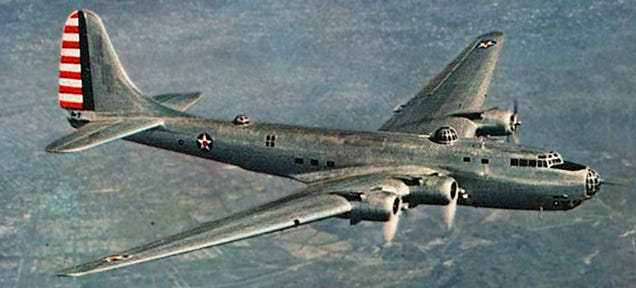
During the mid 1930s, the Army Air Corps wanted to push the technological envelope when it came to building a very long range bomber. Code named 'Project D,' this top-secret initiative would lead to the largest American bomber concept flown during World War II, the massive yet elegant Douglas XB-19...continued at link

Hang around aircraft restorers and you’ll inevitably hear tales of priceless historical relics hidden in barns, buried in shrink wrap, or otherwise stuck in time awaiting discovery.
These stories are almost always wild exaggerations or outright fiction. But if you’ve ever heard of the cache of iconic warbirds at Wilson Connell “Connie” Edwards’ west Texas ranch, it’s absolutely real.
The irascible former movie pilot who made a fortune in the oil business has added to his vast inventory of mostly World War II-era fighters, seaplanes, and surplus parts for more than a half century. Now, he’s decided to sell many of them—but only on his own nonnegotiable terms...continued at link.
LMAO...Mouse droppings. I love the title.
Great thread info too. Thanks.
I grew up in Detroit and went to James Vernors Elementary...named after civil war era pharmacist, James Vernors, the inventor of Vernors Ginger Ale.
Here's another one, that still exists today:
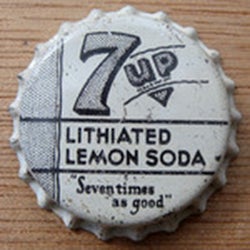
Yesterday, The New York Times published a provocative opinion piece by a Cornell medical school professor that argued for adding lithium to our drinking water. It's an interesting idea! It is not, however, a new one. In fact, one of America's favorite soft drinks used to contain the mood stabilizing element.
When it was initially released, the lemon-lime soda that we know as 7 Up was clumsily called Bib-Label Lithiated Lemon-Lime Soda. "Bib-Label" referred to the paper labels on the bottle, and "Lemon-Lime Soda" obviously referred to the flavor. The "Lithiated" bit, of course, refers to the lithium citrate that inventor C.L. Grigg hoped would make the drink seem more healthy. The drink was also marketed as "slenderizing," which is ironic because weight gain is now a known side effect of lithium...(continued at link)
The Evolution of Potty Training Tech
The Evolution of Potty Training TechExpand
At some point between the terrible twos and terrifying threes, most of us embarked on a pilgrimage to the great ceramic bowl in the sky. It was a long journey, which left in its wake frustrated parents, soiled sheets, and tiny mounds of ill-timed poop. But over time, with practice and patience, we collectively conquered the art of potty usage.
Let's be brief and frank about poop: It's nothing to be ashamed of. Aside from eating and sleeping, it's basically all we do in our early years. For the duration of our lives, it remains one of the simplest, most fundamental human actions. Naturally, being properly trained for something of this significance is incredibly important.
There was a time when potty training was harsh and almost militant; today, with advanced diapers and technology, most parents allow their babies to take control. But this shift has come with a less-than-savory byproduct: It takes today's children nearly twice as long to be fully trained as it did 50 years ago. Is tech to blame? (continued at link)
That's fascinating... met some north vietnamese that apparently only had a great amount of repressed potty rage... they were actually really good guys it appears.
Almost feel sorry for them now that I understand their probable harsh childhoods... ;)
I'm pretty sure it is either Common Core, GW, or RP that is to blame.
BTW, think this may have any impact on how much more difficult it is to get a school-aged child to learn to read? (serious question)
DL's Link
The World's First Powered Submarine Arrived 60 Years Before Its Time
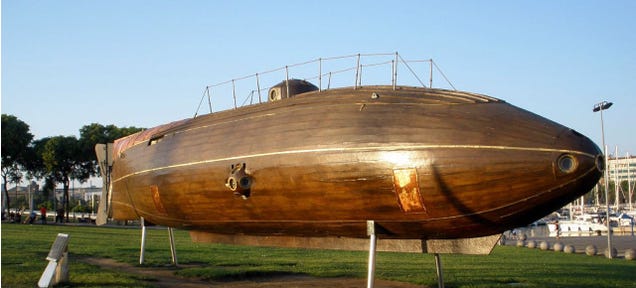 The Axis war effort throughout the first half of the 1940s led to some incredible advances in submarine technology. That includes the anaerobic Walter turbine—a newfangled engine that didn't need oxygen to work. Even more incredible, these discoveries were not entirely new, but in fact more than 60 years old—the fruits of a Victorian-era engineer's labors during construction of the world's first powered submarine.
The Axis war effort throughout the first half of the 1940s led to some incredible advances in submarine technology. That includes the anaerobic Walter turbine—a newfangled engine that didn't need oxygen to work. Even more incredible, these discoveries were not entirely new, but in fact more than 60 years old—the fruits of a Victorian-era engineer's labors during construction of the world's first powered submarine.
Built by Spanish nautical engineer Narcís Monturiol i Estarriol of Catalonia, Spain, the Ictineo II is widely considered the world's first "true" submarine. Unlike contemporary attempts such as the Ictineo I, USS Aligator or CSS Hunley, which were human-powered and required snorkels, the Ictineo II propelled itself using a unique combustion engine that worked underwater.  The World's First Powered Submarine Arrived 60 Years Before Its TimeExpand
The World's First Powered Submarine Arrived 60 Years Before Its TimeExpand
The vehicle's interior - image: public domain
The Ictineo II was constructed of olive wood, measured 46 feet long, more than 6 feet wide, and stood nearly 10 feet tall when out of the water. In the water, she displaced 46 metric tons while providing 1,000 cubic feet of interior room. Compared to the Hunley, which was 4 feet tall at its highest interior point, this thing was downright roomy.
Its propulsion system was a work of genius. In a closed system like that of a submerged vessel, a traditional combustion engine will quickly use up all of the available supply of atmospheric oxygen. So instead, Monturiol devised a solution that mixed zinc, manganese dioxide, and potassium chlorate to create a chemical heat source hot enough to boil the water of an attached a steam furnace and generate power for propulsion. The reaction also generated enough oxygen to support a two-man crew (the rest of that "roomy" interior was actually filled up with equipment).
During the Ictineo II's maiden dive in May of 1865, she made it down to a depth of 98 feet—the perfect level for her intended use: ferrying local coral divers down to their harvests. She would make 20 more successful dives over her three year demonstration career until 1867.
Unfortunately, finances were perpetually tight for the talented Spanish inventor—Ictineo II was financed (and only barely) after Monturiol wrote an open letter to the people of Spain and Cube seeking 300,000 pesetas in public support. Unfortunately, Monturiol was never able to really capitalize on his invention. The sub was repossessed by creditors in 1867, dismantled, and sold for scrap while Monturiol died penniless and forgotten. It would be another 60 years and two World Wars before his contributions to naval technology were rediscovered.
Today, you can find recreations of both submarines in Barcelona, Spain. The Ictineo I stands outside the Marine Museum and its successor stands on display down near the harbor. [Scuttlefish - Wiki - Travelling Spain - Beyond Victoriana - Lowtech Mag]
This Mysterious NYC Castle Was Actually America's First Cancer Hospital

On the southwest corner of Central Park West and 106th Street in New York City, there's an enormous castle. It takes up the whole east end of the block, with its red brick cylindrical turrets topped with gleaming silver cones. The stained glass windows and intricate stonework make the building look like something out of a fairytale.
This building's past, however, is not very fairytale-like at all.
When it was built in 1887, this castle was the country's first hospital devoted solely to the treatment of cancer. In the late 1800s, cancer was known to start as a tumor, but doctors didn't know a whole lot beyond that.
In the back of the castle, was crematorium and a smokestack which was smoking pretty often.
In the late 1800s, a lot of hospitals in the United States didn't want to treat cancer patients because they thought cancer was contagious. Hospitals also had to publish their "death rates," so they'd turn away patients who were likely to skew the numbers. This gave rise to tuberculosis hospitals and other specialty hospitals for diseases that were particularly deadly.
(more of the story and pics at link)
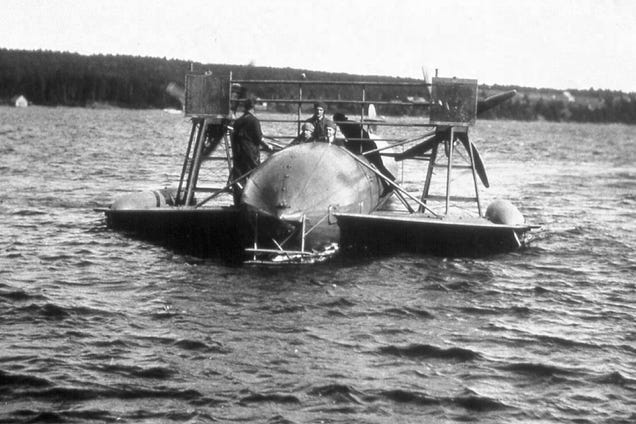

(more photos and info at link)
It bombs crooks.
I have never changed a cylinder or an engine on a B-29, but have on a B-17. Took the crew of volunteers about 8 hours to change a jug. About 3 days to change an engine. Most of the time is spent removing cowlings and exhaust and other odds and ends to gain access to the engine. I am sure the GI's were better than the crew of volunteers I worked with, but the amount of time was enormous. I am betting that there was more time spent maintaining than flying.
The Commerative Air Force has one flying B-29 and I was lucky enough to help keep it flying.
Because the original engines were so unreliable the CAF developed a new engine based on the A-1 Skyraider. They got FAA approval for their mod and 2 million dollars later they had 4 new engines.
The work I did was to take the drawings the FAA had approved and build new baffling that went between the front row of cylinders and the back row. This forced cooling air over the back row of cylinders.
Not only is the engine a reliability success it now has much more power and can thus get into shorter airfields than before expanding the number of airshows they can attend.
Terry
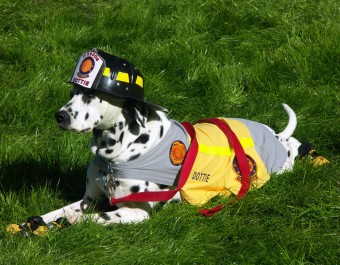
Today I found out why Dalmatians are commonly firehouse dogs.
Dalmatians as firehouse dogs have become so common in books and movies that it’s practically a stereotype. It turns out that Dalmatians actually really do have a strong history in the firehouse, and they used to have some purpose, too.
Before fire trucks, there were horse-drawn carriages. One of the most effective fire-fighting tools in the middle of the 18th century was the steam pumper- a machine that consisted of a boiler which was able to use steam to force water out of hoses and onto a fire. The fire brigade’s horse-drawn carriages would be loaded up with the machine, the horses would be hitched up, and the vehicle would tear off down the road.
When fire fighters were racing off to fight the flames, they didn’t have time for the horses to spook nor to slow down for all the pedestrians using the road, which is where the Dalmatians came in.
Besides being known for forming strong bonds with horses, in the early 1700s, it was observed that Dalmatians were perfectly suited for travelling long distances. As stated by the Dalmatian Club of America, the English felt that Dalmatians had the “strength, vitality, fortitude and size to keep running along under the carriage for hundreds of miles.”
When the travellers rested for the night, the dogs were also useful for standing guard over the horses and the people’s belongings. English aristocrats soon picked up on the practice of having Dalmatians follow their carriages and the dogs even became something of a symbol of social status- the more Dalmatians that ran alongside your carriage, the wealthier you must be.
Back to Dalmatians and the horse-drawn fire carriages- because of the dogs’ strong work ethic and stamina, they typically didn’t have any trouble keeping up with the carriages even when they were flying down the roads at high speeds. The Dalmatian would scare away anything that might spook the horses, and also just as importantly served as the first “siren.” Its bark would alert pedestrians on the road that the fire brigade was on its way, and to move off the street.
The horses were also a bit leery of being so close to burning buildings when it came time to stop. (Can you blame them?) While the firemen unloaded their equipment and rushed off to put the fire out, their trusty Dalmatians would stay with the cart, keeping the horses calm and guarding the firemen’s belongings. Not only that, but once they were back at the fire house, the Dalmatian were often trained to sniff out and kill rats and other vermin—kind of like having a barking cat that was far less lazy than a meowing mouse-catcher.
When the much more efficient motorized fire trucks were created, there were no longer horses for Dalmatians to keep company and no need for them to run ahead of the trucks to alert people that the fire brigade was coming—there were sirens for that now. Their usefulness spent, Dalmatians might have vanished from fire stations altogether. Instead, they turned into fire station mascots, particularly popular when firefighters go around teaching kids about fire safety. Of course, at this point any dog could be used, and sometimes that’s the case, but given the long standing tradition of using Dalmatians, it seems likely they will remain the dog of choice at many fire stations for the foreseeable future.
Bonus Facts:
A common myth is that Dalmatians are kept in fire houses because unlike other breeds, the loud sound of the siren won’t hurt their ears. While it is true that Dalmatians are predisposed to deafness (only about 70% have normal hearing), they were originally around to primarily function as a siren, as stated, so their hearing wasn’t really a factor. Blue-eyed Dalmatians have a higher risk of being deaf than brown-eyed Dalmatians. Studies to find out why have been inconclusive to date. Partially or fully deaf Dalmatians still make excellent pets as long as they have the appropriate training.
The Dalmatian Heritage project started in 2005 and aims to “breed out” the various health defects that plague Dalmatians by only breeding dogs with normal hearing, normal urinary metabolism, and dogs who are friendly and confident.
In Britain, Dalmatians are sometimes called “English coach dogs” or “plum pudding dogs” . Careers other than “fire dog” that Dalmatians are somewhat well suited for include search and rescue, running partner, and guardian.
The exact origin of the Dalmatian is unknown, though it’s likely that the breed originated in the Croatian region “Dalmatia” for which it is named. It’s estimated that they’ve been around for 600 years or more, but the name Dalmatian wasn’t used in the 1780s. Dalmatians gained great popularity in Britain before they spread once again to Europe and, eventually, the Americas.
As you can probably imagine, the popularity of the breed exploded with the release of The Hundred and One Dalmatians book by Dodie Smith in 1956 and the Disney animated film in 1961. This wasn’t necessarily a good thing. Kind of like buying kids a rabbit or baby chick at Easter, parents rushed out to get Dalmatian puppies for their children without researching the breed first to find out if they were right for their family. Aside from needing extra training if the dog has some deafness, Dalmatians are a high-energy breed who prefer running along after fire carriages than sitting with a child as it watches TV. Many of the dogs were dumped at pounds when they were found to be incompatible with certain families’ lifestyles, and as a result Dalmatian rescues were quickly set up to try to find them new homes.
Do Black People Have Equal Gun Rights?
Do Black People Have Equal Gun Rights?
By CHARLES C. W. COOKEOCT. 25, 2014
CONVENTIONAL wisdom holds that firearms are the preserve of conservative white men. You would never know this at my local shooting range, which happens to be in a majority African-American area, and has a clientele that reflects that fact. There, as a white man, I’m often in the minority; just one more guy who likes to fire weapons — another person to chat to and share stories with. It is, I’d venture, how things should be.
By rights, the Second Amendment should serve as a totem of African-Americans’ full citizenship and enfranchisement. For centuries, firearms have been indispensable to black liberation: as crucial a defense against tyranny for Frederick Douglass and Martin Luther King Jr. as for Sam Adams and George Washington. Today, however, many black Americans have a decidedly mixed relationship with the right to bear arms.
In August, as the outrage over the police shooting of Michael Brown in Ferguson, Mo., dominated the news, an African-American group calling itself the Huey P. Newton Gun Club took to the streets of Dallas, rifles in hand, to protest. Local businesses were supportive, and the city’s police chief confirmed in a statement that his department “supports the constitutional rights of all.” On Twitter, the hashtag #blackopencarry prompted a warm response from conservatives. (continued at link)
The Flag of Palestine Before 1948

Above photo: The actual flag of Palestine — 1939. Further proof of the lie (as if we needed any more) of the vicious historical revisionism by the Muslim world to erase the Jewish State and create a mythical Islamic narrative surrounding five thousand years of Jewish history.
The fact is that Palestine is Israel – the Jewish homeland.
After the Romans conquered the Jews in the Jewish-Roman wars, the Romans renamed Israel after the Jews’ worst enemies — the Philistines — in order to further humiliate them.
The term was first used to denote an official province in c.135 CE, when the Roman authorities, following the suppression of the [Jewish] Bar Kokhba Revolt, combined Iudaea Province with Galilee and the Paralia to form “Syria Palaestina”. (source)
It was a Roman Emperor who first coined the name.
In AD 135, the Emperor Hadrian blotted out the name “Provincia Judea” and renamed it “Provincia Syria Palaestina”. This was the Latin version of the Greek name and soon became a name to be used as an administrative unit. This name was shortened to Palaestina and the name “Palestine” was derived from it as a modern and anglicized version. (more here)
In other words, it was always Jewish.
Leading up to Israel’s independence in 1948, it was common for the international press to label Jews, not Arabs, living in the mandate as Palestinians. It was not until years after Israeli independence that the Arabs living in the West Bank and Gaza Strip were called Palestinians. In fact, Arabs cannot even correctly pronounce the word Palestine in their native tongue, referring to area rather as“Filastin.”
The word Palestine or Filastin does not appear in the Koran. The term peleshet appears in the Jewish Tanakh no fewer than 250 times. (Jewish Virtual Library)
 1939 Palestinian Flag. What does it look like? Surprised? From Factual Israel: (thanks to Christian)
1939 Palestinian Flag. What does it look like? Surprised? From Factual Israel: (thanks to Christian)
This a Larousse French dictionary from 1939. In the appendix it lists all the then current flags of the world in alphabetical order. You’ll notice that for Germany at that time the flag was the Nazi one replete with Zwastika which proves that this was pre-1945 ( before 1945).
Now, alphabetically, look for the Palestinian Flag. YES , there is one. What does it look like? Surprised? Oh, but you thought (Mandate Jewish) Palestine was an Islamic Arab-,Turkish-, Circassian Sovereign State that the bad Jews took over , right?  1939 Palestinian Flag. What does it look like? Surprised? From Factual Israel: (thanks to Christian)
1939 Palestinian Flag. What does it look like? Surprised? From Factual Israel: (thanks to Christian)
This a Larousse French dictionary from 1939. In the appendix it lists all the then current flags of the world in alphabetical order. You’ll notice that for Germany at that time the flag was the Nazi one replete with Zwastika which proves that this was pre-1945 ( before 1945).
Now, alphabetically, look for the Palestinian Flag. YES , there is one. What does it look like? Surprised? Oh, but you thought (Mandate Jewish) Palestine was an Islamic Arab-,Turkish-, Circassian Sovereign State that the bad Jews took over , right?
Palestine-Mandate-Jewish-Flag-300x187
Confused?
From 1920-1948 a ( class ‘A’ Mandate) State of Palestine existed as per international law but it was, as all of its major institutions, Jewish. Until the 1960s, name “Palestine” resonated as something Jewish to European ears; the Muslims rejecting the name saying it didn’t belong. The 4,000 year old Jewish homeland or “Land of Israel” or the “Holy Land” were all synonymous!!
The British as legal Mandatory over the Mandate managed or mismanaged the state partially with Jewish Auxilary until Jews regained official sovereignty in 1948, by declaring independence.
The U.N. did not recreate Israel as some people claim.
There are a lot of cultural and historic relics, artifacts and icons that validate the Jewish identity of Palestine.
Take, for example, the leading newspaper of “Palestine,” the Palestine Post (or as it is now known, the Jerusalem Post).
 16 May 1948 edition of The Palestine Post
16 May 1948 edition of The Palestine Post
The Jerusalem Post is a broadsheet newspaper based in Israel, publishing only English and French editions. Its predecessor the Palestine Post was founded in 1932 by Gershon Agron. The name change occurred in 1950.  Screen Shot 2014-11-15 at 2.06.20 PM
Screen Shot 2014-11-15 at 2.06.20 PM
An antecedent paper,The Palestine Bulletin was founded in January 1925 by Jacob Landau of the Jewish Telegraphic Agency.[6] It was owned by the Palestine Telegraphic Agency, which was in practice part of the JTA even though it was legally separate.[6] On 1 November 1931, editorship of the Bulletin was taken over by American journalist Gershon Agronsky (later Agron).[7] In March 1932, a dispute arose between Landau and Agronsky, which Agronsky resolved to settle by establishing an independent newspaper.[6] However, Landau and Agronsky instead came to an agreement to transform the Bulletin into a new jointly owned newspaper.[6] Accordingly, the Palestine Bulletin published its last issue on 30 November 1932 and the The Palestine Post Incorporating The Palestine Bulletin appeared the following day, 1 December 1932. On 25 April 1933, the masthead was reduced to just The Palestine Post, though the newspaper continued to state its founding year as 1925 for at least a year afterwards.
The Origins of the term “Palestinian Arabs”:
No “Palestinian Arab people” existed at the start of 1920, but, by December, it took shape in a form recognizably similar to today’s.
Until the late nineteenth century, residents living in the region between the Jordan River and the Mediterranean identified themselves primarily in terms of religion: Moslems felt far stronger bonds with remote co-religionists than with nearby Christians and Jews. Living in that area did not imply any sense of common political purpose.
Then came the ideology of nationalism from Europe; its ideal of a government that embodies the spirit of its people was alien but appealing to Middle Easterners. How to apply this ideal, though? Who constitutes a nation and where must the boundaries be? These questions stimulated huge debates.
Some said the residents of the Levant are a nation; others said Eastern Arabic speakers; or all Arabic speakers; or all Moslems.
But no one suggested “Palestinians,” and for good reason. Palestine, then a secular way of saying Eretz Yisra’el or Terra Sancta, embodied a purely Jewish and Christian concept, one utterly foreign to Moslems, even repugnant to them.
This distaste was confirmed in April 1920, when the British occupying force carved out a “Palestine.” Moslems reacted very suspiciously, rightly seeing this designation as a victory for Zionism. Less accurately, they worried about it signaling a revival in the Crusader impulse. No prominent Moslem voices endorsed the delineation of Palestine in 1920; all protested it.
Instead, Moslems west of the Jordan directed their allegiance to Damascus, where the great-great-uncle of Jordan’s King Abdullah II was then ruling; they identified themselves as Southern Syrians.
Interestingly, no one advocated this affiliation more emphatically than a young man named Amin Husseini. In July 1920, however, the French overthrew this Hashemite king, in the process killing the notion of a Southern Syria.
Isolated by the events of April and July, the Moslems of Palestine made the best of a bad situation. One prominent Jerusalemite commented, just days following the fall of the Hashemite kingdom: “after the recent events in Damascus, we have to effect a complete change in our plans here. Southern Syria no longer exists. We must defend Palestine.”
Following this advice, the leadership in December 1920 adopted the goal of establishing an independent Palestinian state. Within a few years, this effort was led by Husseini.
Other identities – Syrian, Arab, and Moslem – continued to compete for decades afterward with the Palestinian one, but the latter has by now mostly swept the others aside and reigns nearly supreme.
The Racist Origin of America’s Gun Control Laws
Worth reading.
TODAY IN LAB HISTORY: ISAAC ASIMOV

Isaac Asimov in 1965. Image: Phillip Leonian, New York World-Telegram & Sun, WikimediaIsaac Asimov, the famous science fiction writer, was also a biochemist and professor. Born Jan. 2, 1920, in Petrovichi, Russia, he immigrated to New York City where he was three. Fluent in Yiddish and English he taught himself to read when he was five-years-old. After he graduated high school at fifteen he attended Seth Low Junior College, part of Columbia Univ. He sold his first story at 18.
Though Asimov started as a zoology major, he switched to chemistry. And later, after failing to gain admittance to med school, he studied chemistry as a graduate student, going on he earned his doctorate in biochemistry. His education was interrupted by WWII, which explains why he wasn’t a professor until the ripe old age of 35 when he became a professor of biochemistry at Boston Univ. School of Medicine.
Asimov was continually publishing works of fiction. He was one of the most prolific writers ever with more than 500 book and 90,000 other works to his name. He wrote many nonfiction works explaining science in simple terms and within context for better understanding. Asimov was considered a “Great Explainer” with a non-fiction scientific column in “Venture Science Fiction Magazine.” He contributed to several encyclopedias. And, he also coined the term “robotics.”
He died at the age of 72, on April 6, 1992.
HA/KS's Link

We use 21st century tech terms like hashtag, stream, and mouse with casual indifference, but how did these words get to be so commonplace in our everyday vernacular? We know the origins of Superman (kryptonite), Spider Man (radioactive spider), and Batman (rich boy's revenge) but not "podcast," "spam," or even "hacker." So I looked at 21 common tech terms that have been downloaded into our collective hardware and decoded them.
Spam
Spam for years was known as canned mystery meat worthy of mockery. So much so, that Monty Python did a sketch about it in which the word spam was repeated over and over by a waitress, customers, and even a group of Vikings. Many Monty Python fans were also early MUD, Prodigy, and AOL chatroom frequenters who used the word "spam" to refer to people who created macros to say the same thing over and over again, clogging up chatrooms with their repeated nonsense. So, when repetitive masses of unwanted email began circulating in the early 90s, people familiar with the interwebs began dubbing it spam, and the popularity of the term soared like processed meat at a grade school food fight.
Troll
Rooted in 17th century Scandinavian folklore, a troll once characterized an antisocial, quarrelsome, and slow-witted creature that was bothersome to humans. End of story, right? Nope. The word troll actually derives from the verb "trolling," a fishing technique in which you slowly drag a baited hook from a moving boat.
Many believe the birth of online "trolling" was on alt.folklore.urban, or AFU, when veterans would distinguish themselves from newer users by baiting them with topics that had previously been discussed ad nauseam. Newbies would take the bait and naively reply, exposing their uncool n00b ways. In the late 90s, however, the site became so highly trafficked that trolling was rendered a nuisance, giving the modern tech term once more a negative connotation. The meaning today now more closely resembles its true Norse roots, an idiot looking to pick a fight.
The rest can be seen at the link...
That Time Frank Lloyd Wright Went On What's My Line and Was a Total Crab
A lighthearted 1950s gameshow is the last place most of us would look for Frank Lloyd Wright, America's most well-known—only known?—architect. But in 1956, Wright appeared on the game show What's My Line?, where he endured the indignity of being questioned by a bunch of randos with aplomb.
What's My Line?—which ran for 17 years until 1967—asked its panelists to establish the line of work of its notable guests through a series of yes-or-no questions. FLW, who clearly was having a hard time hearing the panel's questions, was 89 here—but rose to the occasion with a few crotchety zingers, answering that his job "unfortunately" included dealing with law.
It's an interesting little time capsule into both FLW and the way the average American saw him in the 1950s, when his reputation as a genius had long since been established. The building he mentions at the end, Price Tower, became a World Heritage Site a few years ago. [Architect]
img src=http://i.kinja-img.com/gawker-media/image/upload/s--5B0nKcVb--/c_fit,fl_progressive,q_80,w_636/psqaha6t07o6oieuj966.jpg>
Nice article about the A-10
Today is special: Alexander Grahm Bell's birthdate.
Today in Lab History: Alexander Graham Bell
Bell on the telephone in New York (calling Chicago) in 1892.
Alexander Graham Bell, the man credited with inventing the telephone, was born in Scotland on March 3, 1847. It’s no surprise he was interested in sound and communication as his father, brother and grandfather all worked in elocution and his mother and wife were both deaf. His father was, in fact, the author of the famous work The Standard Elocutionist. Bell worked on research about hearing and speech, developing different hearing devices, in 1876, to his being awarded the first American patent for the telephone.
Aleck, as he was known to his family, made his first invention at the age of 12, a machine that dehusked wheat. His best friend, the son of a flour mill operator, had told him about the arduous process, so, Bell created the machine. Grateful for the laborsaving device, his friend’s father gave them space for a workshop. In 1863, he saw an automaton called a mechanical man that emulated a human voice. He and one of his brothers went on to create a machine of their own that could clearly say, “Mama.”
At the age of 23, when both his brothers died of tuberculosis, his parents moved to Canada and he went with them. In 1872, he became a professor at Boston Univ. teaching the deaf. He aggressively taught his pupils to speak orally, wishing to eradicate sign language and fully integrate deaf people into hearing society. Because of his beliefs he is often, to this day, viewed negatively by the deaf community.
The discovery and invention of his telephone was almost accidental as he and Thomas Watson were working on acoustic telegraphy at the time. They were working with metal reeds tuned to different frequencies improve telegraphy. But, when Watson plucked a reed accidentally, Bell heard the overtones of it at the other end of the system and realized it would be possible to communicate a wider verity of tones over the wire. Strangely, he felt the telephone interfered with his “real” scientific work and did not have a phone in his office.

What 170-Year-Old Beer Uncovered From a Shipwreck Really Tasted Like
Back in 2010, divers off the coast of Finland stumbled upon some astonishingly old booze: champagne and beer preserved underwater in a 170-year-old shipwreck. Naturally, they had a taste. But now scientists are back with a rigorous chemical analysis of the beers.
In the initial taste tests, the beer was so sour no one would tell how they were originally meant to taste. But when our noses falter, we have machines. Chemists at VTT Technical Research Centre of Finland looked at two particular bottles of recovered beer, which they called A56 and C49. Before they ran any tests, they recorded their own impressions of the beer's smells, which seem, erh, largely unpleasant.
Bubbles of gas, presumably CO2, formed during sampling, producing a light foam. Both beers were bright golden yellow, with little haze. Both beers smelt of autolyzed yeast, dimethyl sulfide, Bakelite, burnt rubber, over-ripe cheese, and goat, with phenolic and sulfury notes.
Both bottles contained much more salt than usual, suggesting the beers had been diluted with seawater. With modern chemistry techniques, scientists are able to separate out individual compounds and by accelerating them through an electric field, figure out their molecular composition—cutting through the sourness and saltiness to the beer's true character, in other words.
A56 and C49 turned out to clearly be different beers. C49 was much hoppier and thus more bitter. An analysis of yeast-derived flavor compounds—basically the stuff that gives beers its fruity and floral notes—also revealed rose and sweet apples flavors that were high in A56. C49 had a higher concentration of flavor compounds for green tea.
Some flavor differences may be because of how beer was brewed differently in the 19th century. For example, A56 contained much more of a compound called furfural, which is possibly the result of mash being heated over an open fire. Both beers, even when they were fresh, were also more sour than your average modern brew. It wasn't until the late 19th century that brewers learned how to keep acid-producing bacteria out of beer. Until that breakthrough, pretty much all beer, including A56 and C49, was sour beer. Using Yeast DNA To Unlock a Better Beer
Beer may be as old as civilization itself, but modern molecular biology could teach craft brewers… Read more
Back when the shipwreck was first discovered, chemists began analyzing the beer with an eye toward recreating it. But the study published in the Journal of Agricultural and Food Chemistry makes no mention of live yeast cells found in the beers, which makes the whole endeavor a lot more difficult. On the other hand, this study is the first step in a forensic beer reconstruction.
We have a sense of how they tasted—now it's up to brewers to recreate it. Tell me that isn't a gimmick breweries will exploit. [Journal of Agricultural and Food Chemistry]
War brings out many things in a man. The good, the bad and the ugly. These 5 everyday soldiers pulled off amazing feats of bravery at a time when their comrades needed them.
#1 TOMMY PRINCE
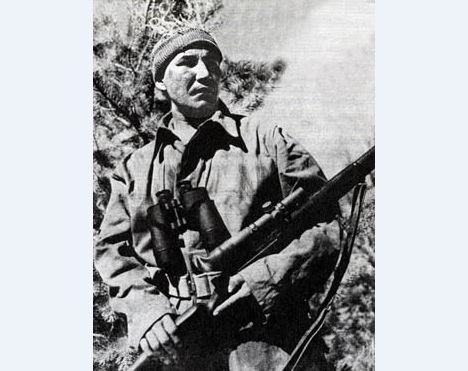
“He moved with absolute quiet because of the pair of moccasins he’d wear… sometimes, instead of killing the Germans, he’d steal something from them. Other times, he’d slit their throats and not make a sound.”
At the outbreak of World War II, Prince volunteered to fight with the Canadian Army and although Prince easily met the requirements for recruitment, he was turned down several times before he was finally accepted on June 3, 1940. He was originally a member of the Royal Canadian Engineers, trained as a sapper. He volunteered for duty with a parachute unit designated the 1st Canadian Parachute Battalion. This designation was used to disguise the true reason for the recruitment of parachute volunteers in the UK at that time: the United States and Canada had begun the formation of a special force to conduct sabotage in Norway. Men were recruited in Canada and the overseas army for this unit, dubbed the First Special Service Force. The Canadians involved with this training continued to be on strength of their prior units. Although later dubbed the 2nd Canadian Parachute Battalion for administrative purposes, the unit did not actually exist. Prince then reported to the U.K.’s parachute school at RAF Ringway, near Manchester. He was promoted to lance corporal in February 1941.
In September 1942, Prince returned to Canada and joined the 1st Canadian Parachute Battalion (1CPB), and was promoted to sergeant. Prince volunteered for the 1st Canadian Special Service Battalion and proceeded to Fort Benning, Georgia where they were forming. The Canadians were well below strength due to injuries in training and washouts. The Canadians then agreed to bolster the 1st Special Service Force (known as the “Devil’s Brigade”) by allowing men to volunteer. Prince, and the other men of this unit were originally chosen for their rugged outdoor backgrounds and received rigorous training, often under live fire. All members of this elite squad received intense instruction in stealth tactics, hand-to-hand combat, the use of explosives for demolition, amphibious warfare, rock climbing and mountain fighting, and as ski troops. Prince became a “Reconnaissance Sergeant” or in the Force table of organization a “Scout”, responsible for moving into forward positions and reporting on the movements of the enemy.
The SSF moved to Italy in November 1943. They would take part in the clearing of the Bernhard or Winter Line preventing the Allied push towards Rome. They attacked and captured Monte la Difensa, Hill 720, Monte Majo, and Monte Vischiataro in December and January. They were then moved to Anzio. On February 8, 1944, near Littoria, Prince was sent forward to report the location of several German assembly points, including artillery positions. From an abandoned farmhouse about 200 metres (660 ft) from the enemy assembly area, he could report the location of the enemy’s emplacements using 1,400 metres (4,600 ft) of telephone wire. An artillery duel followed as the Allies attempted to knock out the guns reported by Prince, and one of these rounds cut the telephone wire. Prince walked out dressed as a farmer weeding the crops; locating the damaged wires, he rejoined them while pretending to tie his shoelaces. He made a show of shaking his fist at the nearby Germans, then again toward the Allied lines. Returning to his lookout spot, he continued his reports, and over the next 24 hours four German batteries were knocked out of action. In all he spent three days behind enemy lines. For this action, Prince was awarded the Military Medal, his citation reading (in part) “Sergeant Prince’s courage and utter disregard for personal safety were an inspiration to his fellows and a marked credit to his unit.”
After being the vanguard of the US Forces liberating Rome on 4 June 1944, the SSF was moved to southern France as part of Operation Dragoon. First they would assault theHyères Islands before going ashore at Sylvabelle on the French Riviera. There the force was ordered, as part of the 1st Airborne Task Force, to push eastward towards the Franco-Italian border. On September 1, Prince and a private were sent forward through the German lines to scout their positions near L’Escarène and came across an encampment area of an enemy reserve battalion. On the way back to report, Prince and the private came upon a battle between some Germans and a squad of French partisans. They started sniping the Germans, who eventually withdrew. When Prince made contact with the French leader, he asked Prince where his company was located, when Prince pointed to the private and said “Here,” the French commander exclaimed that he thought there were fifty of them. The French commander recommended Prince for the Croix de Guerre, but the courier was killed en route and the message never reached the French Commander-in-Chief, Charles de Gaulle.
Prince continued on to his unit. He then led the unit back to the encampment and joined in the battle, which resulted in the capture of the entire battalion, about 1000 men. From start to end, Prince had been without food, water or sleep for 72 hours and had walked over 70 km across rugged, mountainous terrain. Afterward, Prince was recommended for the American Silver Star, his citation reading: “ So accurate was the report rendered by the patrol that Sergeant Prince’s regiment moved forward on 5 September 1944, occupied new heights and successfully wiped out the enemy bivouac [encampment] area. The keen sense of responsibility and devotion to duty displayed by Sergeant Prince is in keeping with the highest traditions of the military service and reflects great credit upon himself and the Armed Forces of the Allied Nations. ”
After it was determined that both US and Canadian personnel would be better suited if they were dispersed to units in their own forces, the 1st Special Service Force was disbanded in December 1944. After returning to the UK, Prince was summoned to Buckingham Palace on February 12, 1945 where King George VI presented him with his Military Medal. Prince would later receive his Silver Star from US General Koening (on behalf of the American President on April 24, 1945; he was one of 59 Canadians to receive this award during the war, and one of only three to receive the Silver Star and Military Medal. In all, Tommy Prince was decorated nine times, the most of any aboriginal soldier in the war. The war in Europe ended while Prince was in England
#2 DIRK K. VLUG
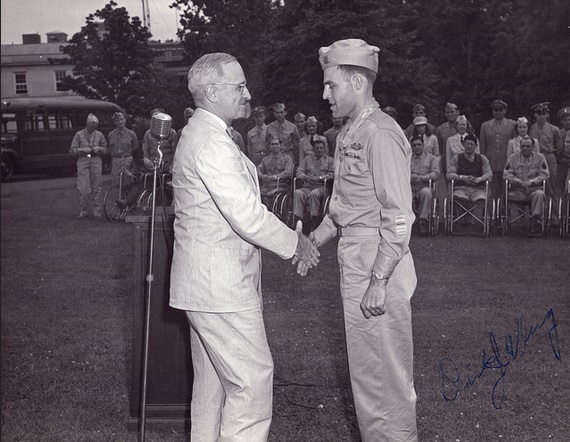
When the crew of the second tank started to dismount it to attack him, he killed one of them with his pistol, forcing the survivors to return to their vehicle. He then destroyed that tank with a second round.
During World War II, this U.S. soldier left behind a path of destruction probably not equaled by many others. His name was Dirk J. Vlug and he served in the United States Army.
What Vlug did almost defies belief. On December 15, 1944, while he was serving as a private first class in the 126th Infantry Regiment, 32nd Infantry Division, Vlug single-handedly destroyed a total of five enemy tanks.
Here is the order of what went down:
He left his covered position and brought with him a rocket launcher and 6 rounds of ammo. He advanced by himself under intense enemy machine gun and 37-mm. fire.
He loaded his rocket launcher and destroyed the first tank, killing its occupants with a single round.
When the crew of the second tank started to dismount it to attack him, he killed one of them with his pistol, forcing the survivors to return to their vehicle. He then destroyed that tank with a second round.
Three more hostile tanks moved up the road. He flanked the first and destroyed it.
Despite a massive amount of enemy fire, he pressed forward again to destroy another.
With his last round of ammunition he struck the remaining vehicle, causing it to crash down a steep embankment.
In all, Vlug alone destroyed 5 enemy tanks which led to the successful accomplishment of his battalion’s mission. In case you missed that, lets had you over to BadAssOfTheWeek
It turns out that there were a pair of Japanese tanks headed his way, looking to break through the U.S. roadblock. Dirk took one look at this and was like, “Aw hell naw, bro”. He left his posh country-club community-style guardhouse, abandoned his portable TV, grabbed his bazooka and six rockets and ran out to let those fu*kers know exactly what was up for really real this time.
PFC Vlug, having left his fortified position, calmly walked towards the enemy tanks as they tried to blast the shit out of him with their machine guns and 37mm cannons. Not surprisingly, they couldn’t hit the side of a barn if they were parked inside of it, and Dirk just fearlessly walked up to the first tank, took a big puff off his cigar, cracked his neck to the side and then fired his bazooka one-handed at the Japanese tank, blasting the shit out of it.
After seeing this dude with a bazooka blowing their comrades up, the crew from the second Japanese tank opened the hatch and came piling out after Dirk. Once they were all out of the tank, they pulled out huge ass samurai swords and those crazy white headbands with the Japanese sun in the middle of them and started yelling the Japanese equivalent of, “I kill you, motherfucker!” while charging towards PFC Vlug. In one swift motion, Dirk flicked the lit cigar into the eye of one of the Japanese dudes, quick-drew his .45-caliber Colt 1911 from his thigh holster and plugged another Japanese tanker right between the eyes. The Japanese, totally freaked out by this, ran back into their tank to try and turn the 37mm on him. Dirk laughed, possibly said some sort of witty James Bond-style one-liner, popped another rocket into his bazooka and blasted the tank into the stratosphere.
Peering through the two smoldering craters, PFC Vlug noticed three more Japanese tanks rolling towards him. Dirk sighed, loaded another rocket and headed around to flank the relief column.
PFC Vlug made it around to the flank and blew the crap out of another Japanese tank. Once they figured out what was going on, the Japanese tanks started trying to shoot Dirk to death (nobody had informed them that he was completely fucking bullet and rocketproof) but could not succeed in that endeavor. PFC Vlug blew up his fourth tank, reloaded and fired his last rocket at the fifth and final tank. The impact of the blast on the final tank knocked it off a cliff where it tumbled all the way down and exploded at the bottom like the tank in Indiana Jones and the Last Crusade but with more Japanese and no Nazis. And in this case, after the tank exploded the tiny pieces caused by the explosion actually exploded some more.
#3 FRITZ CHRISTEN
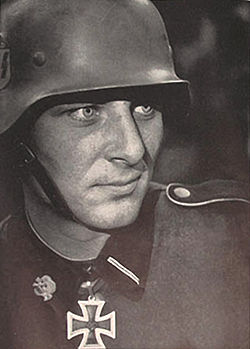
Having missed the Polish campaign, and having cut its teeth successfully in France, the Totenkopf division was heavily embroiled in combat on the Eastern Front from the first days of the German invasion of the Soviet Union. On the morning of September 24, 1941, Christen and his anti-tank battery were engaging Russian targets north of the village of Lushno (Luzhno). In an initial engagement, Soviet skirmishers killed all of the other men of the battery. While exposed to artillery and small arms fire, Christen manned his 50mm cannon alone, holding on without supplies or provisions for the next three days.
When a counterattack by other Totenkopf troops recaptured Lushno, Christen was credited with having knocked out 13 Soviet tanks and killed nearly 100 enemy soldiers singlehandedly. The soldiers that greeted him were baffled that a single artilleryman could hold his position against hundreds of Soviet troops and a formidable armor presence. For this stunning act of individual bravery, SS-Obergruppenführer Theodor Eicke awarded Christen with the Iron Cross, First Class and recommended him simultaneously for the Knight’s Cross. Subsequently, Hitler awarded him the Knight’s Cross, making Christen the first enlisted man in his division to be given the honor.
Christen served with distinction for the remainder of the war. In spring 1945, he was captured by the Americans along with the remainder of the depleted Totenkopf division in Czechoslovakia. He and the remnants of the division were turned over to the Soviets and few survived. Soviet-held POWs, especially those from the Waffen-SS, often died in their lengthy captivity. Christen, along with many of the men in his unit, endured ten years in a Soviet gulag before being returned to Germany in 1955. He died of natural causes in 1995.
#4 LACHHIMAN GURUNG
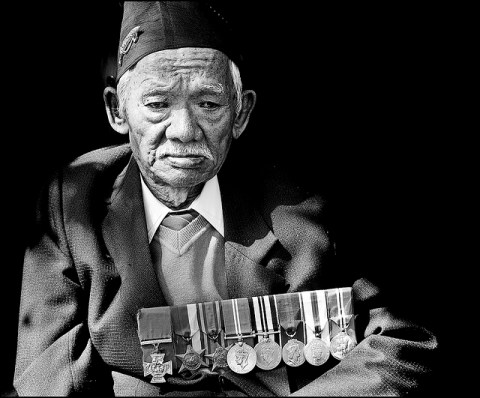
“I had to fight because there was no other way. I felt I was going to die anyway, so I might as well die standing on my feet. All I knew was that I had to go on and hold them back. I am glad that helped the other soldiers in my platoon, but they would have all done the same thing.”
He joined the British Indian Army in December 1940, permitted to enlist in wartime although only 4’11” tall and so below the peacetime minimum height. He was 27 years old, and a Rifleman in the 4th Battalion, 8th Gurkha Rifles, in the Indian Army during World War IIwhen the following deed took place in May 1945 for which he was awarded the VC.
His Battalion was part of the 89th Indian Infantry Brigade of 7th Indian Infantry Division, which was ordered to cross theIrrawaddy River and attack Japanese forces to the north of the road from Prome to Taungup. The Japanese withdrew towards Taungdaw, where Gurung was part of the two companies of the 4th Battalion, 8th Gurkha Rifles waiting, when the Japanese attacked in force in the early morning.
On 12/13 May 1945 at Taungdaw, Burma [now Myanmar], Rifleman Lachhiman Gurung was manning the most forward post of his platoon which bore the brunt of an attack by at least 200 of the Japanese enemy. Twice he hurled back grenades which had fallen on his trench, but the third exploded in his right hand, blowing off his fingers, shattering his arm and severely wounding him in the face, body and right leg. His two comrades were also badly wounded but the rifleman, now alone and disregarding his wounds, loaded and fired his rifle with his left hand for four hours, calmly waiting for each attack which he met with fire at point blank range. Afterwards, when the casualties were counted, it is reported that there were 31 dead Japanese around his position which he had killed, with only one arm.
He received his Victoria Cross from the Viceroy of India, Field Marshal Lord Wavell at the Red Fort in Delhi on 19 December 1945.
Gurung was hospitalised for the wounds he received during the above action and subsequently lost his right eye and the use of his right hand, but he continued to serve with the 8th Gurkhas, choosing to remain with them when they were transferred to the newly independent Indian Army in 1947. He later achieved the rank of Hon. Havildar and he returned to his village in Nepal on completion of his service in 1947, where he farmed on a smallholding.
#5 SERGEANT WARREN G. H. CRECY
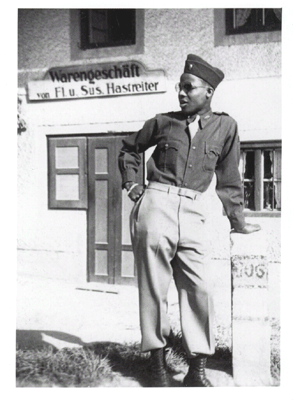
According to the unit historian, Crecy was a pretty mild-mannered, well-liked guy. He was quiet, unassuming and polite. But when he got out on the battlefield and had some Germans shooting machine guns at him, Crecy would totally flip out and become an unstoppable killing machine.
Tank commander Sergeant Warren G. H. Crecy came to the aid of his men on 10 November 1944, and fought through enemy positions until his tank was destroyed. He eliminated an enemy position that had knocked out his tank by commandeering a vehicle armed with only a .30-caliber machine gun. He then eliminated the German forward observers who were directing artillery fire on the US positions.
After manning a replacement tank, Crecy’s new vehicle lost traction in heavy mud and he was forced to exit the tank under fierce machine gun, antitank, and artillery fire to free the tracks. When attacked by German infantry, he had to abandon his salvage efforts to man the .50-caliber machine gun, effectively holding off the advancing enemy, then forcing them to withdraw.
Described as a baby-faced, “quiet, easy-going, meek-looking fellow”, Crecy had destroyed an antitank position and a number of German machine gun positions armed only with a machine gun and without regard for his personal safety, under heavy fire. His men reportedly experienced difficulty getting the machine gun away from him after the action.
Crecy was nominated for the Medal of Honor and received a battlefield commission, eventually retiring with the rank of major. His heroic actions earned him the title “Baddest Man in the 761st” from his comrades.
The unit historian dubbed Crecy “the baddest man in the 761st”, crediting him with about 300-400 kills during the war. For the actions described above, Crecy was nominated for the Medal of Honor. During the rest of his service he would receive another Bronze Star for bravery and four Purple Hearts as well.
After the war, Warren Crecy served as a prison guard at Nuremberg, where he was entrusted with making sure that the most notorious war criminals in the history of the world didn’t get away. They didn’t. He returned home in 1950 only to face racism and segregation from the country he had fought so hard for. This didn’t discourage him though, and when the country called on him again Crecy shipped out to fight in Korea.
In October of 1952, Crecy was hit with a mortar shell which left him severely injured. He was shipped home and would spend the next ten years in and out of various military hospitals. He passed away in 1976 – a war hero, a pioneer who helped pave the way for the desegregation of the Armed Forces, a fearless survivor and warrior.
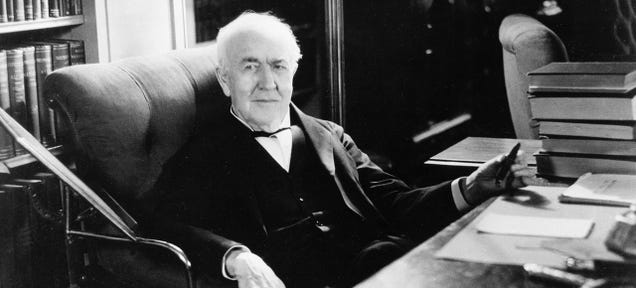
Take The Intelligence Test That Thomas Edison Gave to Job Seekers
Today tech companies are infamous for asking silly questions at job interviews. How would I move Mount Fuji? If I knew that I probably wouldn't be sitting here for this job interview, would I, Microsoft?
But companies like Apple and Facebook don't put employees through anything quite as exhausting as Thomas Edison's test for potential employees. It was filled with trivia largely considered irrelevant to any job under Edison, but the quiz was all anyone could talk about when the questions leaked in the Spring of 1921. And if you're a trivia masochist you can take the test below.
Americans obsessed over the test following publication of many questions in the May 11, 1921 New York Times. From there the test was debated, copied, and parodied in newspapers and magazines around the country. By May 13, 1921 a full 146 test questions and answers, as remembered by two applicants with apparently fantastic memories, was published in the Times.
Everybody had an opinion on the test, and those who scored well weren't shy to tell you about it. However, those who did well were definitely in the minority.
The Chicago Tribune sent reporters down to the University of Chicago to see how students would fare. They asked them each 20 questions and nobody did well. Male students averaged a score of just 35 percent. Female students? Just 28 percent. The newspaper warned that this was a sign that kids these days were getting dumber.
Reporters even quizzed Albert Einstein, who was said to have "failed" Edison's quiz for not knowing the speed of sound off the top of his head. Edison's youngest son Theodore, a student at MIT, did poorly as well when questioned by a visiting reporter. But according to the Edison biography by Randall Stross, the elder Edison assured his son he had guaranteed employment anyway. Ironically, Edison was said to have created the test because he was frustrated with college-educated applicants looking for work who didn't have the proper knowledge.
As the National Park Service points out, the test was changed multiple times after it leaked with the answers. But that didn't stop Americans from discussing the test as if it were the ultimate barometer of intelligence, and comparing notes on how well they did.
Want to take the test for yourself? Be my guest. But remember that you have to answer as if you're living in 1921. Which, even with Google, is a bit tough. If you want to cheat, go ahead and skip to the bottom, where we've supplied the answers as they appeared in the New York Times. Any odd spellings have been maintained.
146 Questions...and answers at link.
How'd you do?
Paleolithic Hunters Poisoned Their Weapons
Archaeologists have long suspected that our Paleolithic ancestors used plant poisons to make their hunting weapons more lethal. Now, Valentina Borgia, of the Univ. of Cambridge, has teamed up with a forensic chemist to develop a technique for detecting residues of deadly substances on archaeological objects.
We’re surrounded by poisonous plants: they thrive in our parks and gardens, hedgerows and woodlands. Foxgloves (Digitalis) look charming but their seeds can kill. The flowers of monkshood (Aconitum napellus) are a stunning blue but its roots can be deadly. Hemlock (Conium maculatum) is both common and extremely toxic as Shakespeare reminds us in Macbeth with the incantations of the witches.
Archaeologists have long believed that our ancestors used poisons extracted from such plants to make their weapons more lethal and kill their prey more swiftly. By dipping an arrow head into a poisonous paste, the hunter could ensure that an animal would receive a dose of toxic chemicals — alkaloids or cardenolides — that would either kill it immediately or slow it down.
Until very recently it has been impossible to prove that poisons extracted from plants were used by early societies. Borgia, a specialist in Paleolithic hunting weapons and Marie Curie Fellow at the McDonald Institute for Archaeological Research, believes that she is on the brink of being able to prove that our ancestors used poisons as far back as 30,000 years ago.
Borgia has approached the likely use of poisons by our distant ancestors from a number of viewpoints. Her research looks at the ubiquity of poisonous plants in many local environments and their use both historically and by modern hunter-gatherers. Working with a forensic chemist she has also developed techniques capable of detecting tiny residues of poison on archaeological objects. She is now putting those techniques to the test with samples obtained from museum collections.
“We know that the Babylonians, Greeks and Romans used plant-based poisons both for hunting animals and in war. In fact, the word ‘toxic’ come from toxon, the Greek for bow. Taxus is a genus of the yew tree with a springy timber traditionally used to make bows. It also produces seeds used to poison arrows. In Britain, yews grown for their timber were planted in churchyards so that animals wouldn’t be poisoned by eating their berries,” says Borgia.
“Few hunter-gatherer societies remain today but all the groups that have survived employ poisons. The Yanomami people of the Amazonian rainforest use curare — a mix of Strychnos genus plants — to poison their arrows. In Africa, a variety of different plants are used to make poisons. Acokanthera, Strophantus and Strychnos are the most common.”
Many Northern Asian populations used monkshood (Aconitum) to kill large animals such as bear and Siberian ibex. Poisonous plants also feature in folklore. In Malaysia, darts are poisoned using Antiaris toxicaria, a poison that comes from the Upas tree. A Malaysian legend says, “Seven up, eight down and nine no life.” The victim takes seven steps uphill, eight steps downhill and a ninth final step.
In 2014, Borgia enlisted the expertise of forensic chemist Michelle Carlin, of Northumbria Univ., to help her devise a method for identifying residues of poison. Carlin’s day-to-day work is focused on crime and the detection of illegal substances through chemical analysis. Using a highly specialist technique called liquid chromatography-mass spectrometry, she is able to detect invisible traces of drugs – such as cocaine in pocket linings.
The same technique can be used to detect the presence of poisons used thousands of years ago. Together Borgia and Carlin have created a database listing toxic plants and have developed a nondestructive method of collecting samples of residues from archaeological materials, by simply touching the item with cotton imbued with pure water.
Samples of poisonous plants were supplied to the researchers by the Botanic Garden at the Univ. of Cambridge and Alnwick Castle in Northumberland. Alnwick has a Poison Garden where visitors can see 150 poisonous plants. Some (such as monkshood) are so toxic that Alnwick has to obtain a license from the Home Office in order to cultivate them.
Another route to identification of plant residues is to look for the presence of starches that remain on the surface of the prehistoric weapons. Starch grains can be used to determine plant taxa: each species has distinctive size, shape and structure. Borgia has collaborated with a major expert in this methodology, Huw Barton, of the Univ. of Leicester, in order to use starching testing as one of her research tools.
Many museums with ethnographical collections have poisoned weapons in their displays and stores. Borgia has been able to collect samples from objects held by the Museum of Archaeology and Anthropology in Cambridge, the Pitts Rivers Museum in Oxford and the Museo Etnografico Pigorini of Roma (Italy) with the collaboration of her Italian colleague, Jacopo Crezzini. The objects include a Chinese pot with Aconite poison inside (wrapped in a newspaper dated July 13, 1926), Malaysian darts poisoned with Upas, various African arrows and a glass tube containing curare.
“The wonderful craftsmanship used to create objects so strongly associated with poison is also significant. As the French philosopher Simondon says, there is no pure technical device free from symbolic meaning,” says Borgia. “These artefacts fully express this concept, as they show a high degree of care. A scary-looking Borneo harpoon, wonderfully carved, in the Cambridge museum is thought to have been made from a human bone. A card, conserved with it, warns ‘Care. Has been poisoned.’”
Carlin’s analysis of these samples of materials has shown that residues of poisons are easily detectable on the objects a century later and that the residues retained their chemical characteristics. Now the real challenge for the researchers is to go much further back in time.
Testing of a sample of six stone-tipped pre-dynastic Egyptian arrows, dating from 4,000 years BC and conserved in the Phoebe A Hearst Museum of Berkeley, is now taking place. At the time these arrows where first studied, 40 years ago, the researchers removed small portions of the black residue present on the tips, and injected into a cat. The reaction of the poor animal — which did survive — was evidence of the presence of a poison on the arrows.
“Nowadays we have the right instruments to get more information without cruelty to animals. Initial tests strongly suggest the presence of Acokanthera, a poisonous plant on our database, but we can’t be completely certain as there are a number of components in the compound,” said Borgia.
“It made good sense for people to use poisons. On their own, Paleolithic weapons with stone arrowheads may not have been deadly enough to immobilise or kill a large animal such as a red deer. Poisons plants were plentiful and the Prehistoric population knew the environment where they lived, they knew the edible plants and their potential as medicines and poisons. To fabricate a poison is easy and economic, and the risk is minimal. In addition, the making of poisons is often part of the tradition and the rituality of hunting.”
When archaeologists remove items from the ground in the course of field work, they brush off the soil adhering to the finds and sometimes even wash objects. Borgia is appealing to fellow archaeologists to contact her when they find weapons and not to clean up their finds. “Now we have this technique available, and have shown that it works, we need to test it as much as possible on archaeological samples,” she says.
Borgia denies that her family name (Lucrezia Borgia is legendary as a devious poisoner) prompted her interest in poisons but she delights in the Latin quip “nomen omen.” It translates roughly as “significant name” and certainly the name Borgia has powerful historic resonances. Luckily for Borgia’s colleagues, her objectives are honorable and entirely academic.
She says, “Investigation of the use of poisons in Prehistoric periods adds to our understanding of hunting techniques and rituals, and also how the plant world was exploited. The Renaissance physician Paracelsus wrote that dosis facit venenum (the dose makes the poison). Ethnographic studies tell us that the most common toxic plants used in poisons were also used to treat diseases. Not surprisingly, the same substances are the basis for many medications still in use today.”
By Sha'i ben-Tekoa
Thomas Jefferson, Patron Saint of American Liberals, would not recognize his spiritual offspring in today’s liberal President Obama and his handling of the Middle East.
Jefferson, as a trade commissioner and then ambassador in Paris for six years (1784-90), faced almost daily the tragedy of American hostages enslaved by violent Muslims and his own frustrating inability to liberate them.
However, what he learned served him well as the leading hawk for war a decade later when he became president and went to war against belligerent Islam.
In May, A.D. 1784, immediately after America’s Continental Congress, gathered in Annapolis, had signed the final draft of the treaty with England that formally ended the American Revolution, Congress appointed Benjamin Franklin, John Adams, and Thomas Jefferson as “trade commissioners” in an effort to open European markets to American commodities -- not an easy mission with Europe’s traditionally closed, mercantile economic system.
But when Jefferson reached Paris in August 1784 to join the other two already there, he discovered that one unanticipated reality posed the greatest and most immediate threat to their fledgling United States. Every state was swamped in Revolutionary War debt and the way to pay it off would be shipping to European markets their great natural wealth, e.g. lumber from their endless forests, the produce of their fertile soil, the skins of animals for clothing, etc. But with the thirteen ex-colonies now independent of England, when their merchant ships crossed the Atlantic Ocean now, they would no longer be protected by the Royal Navy, the greatest in the world and by the “tribute” that the King of England paid to the pashas of Tripoli, Tunis, Algiers, and the Sultan of Morocco. This was basically protection money given to North Africa’s so-called “Barbary Pirate” states to keep them from preying on British shipping.
When Jefferson boarded his friend Mr. Tracy’s private vessel in Boston Harbor in July 1784 for the month-long voyage, he took along for reading Don Quixote, Cervantes’s classic novel in which several central chapters take place in the slave dungeons of Algiers episodes based on Cervantes’ own five years as a Christian slave to the Muslims, so the subject of Barbary piracy could not have been wholly foreign to Thomas Jefferson, principle author of America’s Declaration of Independence.
But what surprised him was that, contrary to popular usage, these North African predators were not common pirates out for loot -- who when ashore liked to hang out in taverns, get drunk, sing “yo ho ho” and paw at wenches. No, these “Barbary Pirates” were in fact just normal Middle Eastern Muslims -- or Mahometans or Mussulmen as they were then called -- who did not drink alcohol at all. Unlike real pirates, they also prayed to Allah several times a day. Not at all venal, independent freebooters, they were simply the crewmen in the official cruisers of the Mediterranean Sea’s Islamic city-states. While their livelihood was capturing cargo and passenger vessels, their rationale for doing so was religious. They saw themselves engaged in a jihad and called themselves mujahidin/soldiers in the jihad. In the late 18th century, one man’s pirate was another man’s holy warrior.
Jefferson, like Franklin and Adams, expected that his principle work for Congress would concern trade with Europe, but saw right away the immediate danger to U.S. freighters no longer protected by warships flying the Union Jack. America’s ships would now be flying the Stars and Stripes, which flag no Mussulman had ever seen.
Jefferson foresaw catastrophe and thus spent the fall of 1784 reading up on Islam and probing fellow diplomats in Paris on how their countries dealt with the problem. He discovered that for a thousand years the Muslims of North Africa had plagued Europe with their hijacking, hostage-taking, and enslaving. (In truth, Europe also engaged in capturing Muslims and selling them in slave markets too, but that practice had died out earlier in the century.)
Jefferson discovered that in practically every century some European country got fed up and ordered its navy to bombard these Muslim port cities where on any given day there were thousands of Christian enslaved.
But no bombardment ever succeeded in ending the menace. There was also, from Europe’s perspective, a religious dimension to the relationship. Christians were themselves, for over a thousand years, locked no less in an eternal holy war with Islam that, according to Catholic doctrine, was not another religion but a heresy with which there could be no peace. The kings of Catholic Spain on their coronation oaths for centuries pledged eternal war against infidel Muslims. The Crusades may have ended centuries earlier but not the animosity between the two cultures or the low-level violence.
Jfferson learned as well of a major turning point in history that occurred in the 1680s when Protestant England of Max Weber’s The Protestant Ethic and the Spirit of Capitalism became the first Christian state to dismiss religion and see the problem pragmatically. British merchants reasoned that it would be better to pay the tribute that the Mahometans were demanding to refrain from their barbaric attacks. It made better commercial sense to pay the “tribute” and free the Royal Navy for safeguarding their burgeoning global empire elsewhere. Why remain bogged down in the Mediterranean to protect the increasingly smaller percentage of their business?
Two years later, Louis XIV of France copied England and before long, every maritime trading country in Christian Europe was paying for the right to do business in the Middle East unmolested.
But Jefferson also learned that the purchase of peace was at best temporary. The Mussulmen would always find some excuse to break the agreement, claim it was the European country’s fault, renew the hijacking, and force new negotiations for higher tribute.
Jefferson is remembered as the father of the American principle of a “wall of separation” between church and state and thus was appalled that in their enlightened age -- what friend Tom Paine nicknamed “The Age of Reason”-- there were still such people in the world as these Muslims who continued to kidnap and enslave people as part of their religion.
Jefferson also discovered that the ‘tribute” was in reality less a demand for cash and jewels, spices and fine fabrics, and more about weapons. The “tribute” was largely a demand for arms shipments of ammunition and naval supplies without which the “pirates” could not be pirates at all. The Muslims were much too backward to have their own foundries capable of producing cannon and shot, iron spikes, gunpowder, and the nails required for wooden sailing ships.
And the Europeans, led by the English and the French, were only too happy to oblige. Sending weapons meant helping the Arabs arm themselves for their attacks on other Christians, meaning, fellow Europeans traveling on innocent sailing vessels. European states were routinely in a state of war with one another, so, for example, what cared the French if the weapons they supplied the Algerines (sic) and Tripolitans (sic) were used to hijack and enslave Englishmen and Spaniards?
So Trade Commissioner Jefferson, after three months in Paris and research into the history and menace of militant Islam, formulated a policy in opposition to his partners, both of whom had spent years as diplomats in Europe. Benjamin Franklin the Quaker reckoned that since most U.S. maritime business was conducted elsewhere, U.S. importers and exporters should just avoid that dangerous sea. He did not think the country did enough business there to warrant the risk.
But John Adams, a lawyer to Boston merchants well-versed in maritime commerce and the laws of piracy, knew that in fact the U.S. did enough business in the Mediterranean not to want to abandon that market. He too knew something of the history of the threat and reasoned that since the superpowers England, France, and Spain with their major navies had chosen the path of tribute rather than violence, America with no navy had no choice. After the Revolution, the U.S. had sold off or scrapped every armed vessel it owned.
But Jefferson, the future father of original American Liberalism, wanted to fight. He found it intolerable that their revolutionary and little-in-population, infant republic would join this corrupt European practice in which civilized nations gave arms and money to uncivilized “barbarians” -- his word -- who used the weapons to attack civilized people and enslave them as part of a “holy war,” no less.
Within weeks of formulating his strategy for dealing with Islam, which included his prescription for the building of a fleet of American warships, news of a hijacking by Morocco reached him in Paris. In the following summer of 1785, two more American vessels were captured, this time by Algiers. The ten merchant seamen seized by the Moroccans would be ransomed after nine months by Congress for $40,000 which capitulation Jefferson protested against, but not the twenty-one others enslaved in Algiers.
Jefferson remained in Paris for another five years during which time he and Adams never succeeded in freeing the American slaves in Algiers. They were still there when in 1790 Jefferson returned home to become the United States’s first Secretary of State and among his first acts was filing a report on the depressed status of American commerce in the Mediterranean and the plight of the hostages still in Algiers.
For the next three years, Secretary of State Jefferson was the No. 1 hawk for war in America pressing Congress and President Washington to build a navy to rescue the hostages and put an end to hijacking, hostage taking, and enslavement in the Mediterranean.
In 1792, he commissioned John Paul Jones, the great naval hero of the Revolution who was a fellow radical liberal, to sail for Algiers to see what could be accomplished diplomatically but also covertly, to size up the place as a possible target for a U.S. attack, though Jones died before he could execute the mission.
In late 1793, Secretary of State Jefferson wanted to retire, and in his last report to Congress on any subject he dealt again with the menace of militant Islam and the recent, dreadful news that Algiers had struck again, this time hijacking eleven more American merchant ships carrying over one hundred seamen and passengers. He outlined the blow to the American economy. When word reached New York of the mass hijacking, the stock market crashed. In the few days it took for the news to travel up and down the Atlantic seaboard, voyages were canceled in every major port; seamen were thrown out of work, ship stores merchants went out of business. What 9-11 did to the U.S. economy in 2001, the mass hijacking by Muslims in late 1793 did too.
So it is not surprising that four months later, on March 27th, 1794, Congress -- after debating the topic sporadically over a decade since the first hijacking to Morocco -- finally decided to build a fleet of warships: six extra-large frigates including the first Constellation, today a tourist attraction in Baltimore’s Harbor Place and Constitution (the future “Old Ironsides”) in Boston harbor. In a nutshell, the United States Navy was born in response to unprovoked Muslim aggression.
Congress’s compromise was to build the ships and hope that the construction itself would frighten the Algerines while at the same sending negotiators to appease them by imitating Europe and offering to join the tribute system. The Naval Establishment Act tried to please both hawks and doves by ordering the building of a fleet while simultaneously sending negotiators, with the text specifying that if they succeeded, the building of the warships, immensely expensive in every generation, would stop.
And that is what happened. The U.S. wound up paying close to $1,000,000 in ransom and to atone for its tardy delivery in barrels of gold coins also agreed to build for free a brand new warship as a gift to the pasha of Algiers. It was built in Portsmouth, New Hampshire and christened “The Crescent,” in honor of the Islamic flag.
Jefferson, understandably, objected to the national humiliation under his erstwhile friend President John Adams.
In 1796, eighty-five surviving American hostages, crippled and emaciated by the ordeal, were freed from slavery.
Eventually the shipbuilding resumed, but the menace of Barbary piracy remained. Not until 1801 was action taken when Jefferson became America’s third president. After 17 years of calling for war, one of his first acts was dispatching a naval squadron of four warships to the Mediterranean, and what ensued was a four-year war “to the shores of Tripoli” memorialized in glory for generations of Americans to come, one of whose dashing heroes was Navy Lieutenant Stephen Decatur, Jr. after whom more than a dozen American towns and counties would be named.
Imperialism, Colonialism, and Slavery
This is a really long article and I won't paste it here. However, it is a really good and interesting read and I highly recommend reading it.
There is a lot of historical information that is relevant to our present times.
Slavery was common throughout the world - including the Americas - before Columbus.
It doesn't make slavery in America right, but it puts it in context.
"Champ, what did you think of Africa?" Ali replied, "Thank God my granddaddy got on that boat!"
This Heroic Captain Defied His Orders and Stopped America From Starting World War III

It’s truly amazing that anybody survived the Cold War.
Over the past decade numerous stories have come out about Soviet and American military personnel who were given orders to fire nuclear weapons between the 1960s and 1980s. Their conscience stopped them, only to learn later that it was a mistaken order. We now have another horrifying story to add to that growing list of possible post-apocalyptic futures.
Former Air Force airman John Bordne is now an elderly man. But in the early morning hours of October 28, 1962 he and his fellow airmen nearly launched their nuclear weapons during the Cuban Missile Crisis. The Air Force has only now given Bordne permission to tell his story of how America nearly started World War III.
From the Bulletin of the Atomic Scientists:
By Bordne’s account, at the height of the Cuban Missile Crisis, Air Force crews on Okinawa were ordered to launch 32 missiles, each carrying a large nuclear warhead. Only caution and the common sense and decisive action of the line personnel receiving those orders prevented the launches—and averted the nuclear war that most likely would have ensued.
Captain William Bassett received the orders to launch his four nukes. They even went through three layers of security codes, getting confirmation each time that they were correct.
When the captain read out the target list, to the crew’s surprise, three of the four targets were not in Russia. At this point, Bordne recalls, the inter-site phone rang. It was another launch officer, reporting that his list had two non-Russian targets. Why target non-belligerent countries? It didn’t seem right.
Aside from targeting yet unnamed non-enemy countries, the other part that didn’t seem right was that they were only at DEFCON 2. If this was for real, they probably should’ve been at DEFCON 1. So the Captain stalled and called the Missile Operations Center, lying about not hearing clearly the instructions to fire.
The men with their fingers on the trigger were ready to launch the nukes, but by Bordne’s recollection, the Captain stalled again and ordered two armed airmen to “shoot the [lieutenant] if he tries to launch without [either] verbal authorization from the ‘senior officer in the field’ or the upgrade to DEFCON 1 by Missile Operations Center.”
“If this is a screw up and we do not launch, we get no recognition, and this never happened,” Bordne recalled Captain Bassett saying in the harrowing moments before they nearly started World War III.
By Bordne’s account, the Captain told Missile Operations Center over the phone that he either needed to hear that the threat level had been raised to DEFCON 1 and that he should fire the nukes, or that he should stand down. We don’t know exactly what the Missile Operations Center told Captain Bassett, but they finally received confirmation that they should not launch their nukes.
After the crisis had passed Bassett reportedly told his men: “None of us will discuss anything that happened here tonight, and I mean anything. No discussions at the barracks, in a bar, or even here at the launch site. You do not even write home about this. Am I making myself perfectly clear on this subject?”
Captain Bassett died in 2011 and nobody said a peep for over 50 years. Until now, of course.
Researchers are now calling for a complete account of this incident to be released and the National Security Archive has filed FOIA requests to that effect. You can read Bordne’s full account of this terrifying incident over at the Bulletin of the Atomic Scientists. But for now we can add another near-miss of worldwide destruction to the history books.
The Secret WWII Club That Healed Burned Pilots and Revolutionized Plastic Surgery
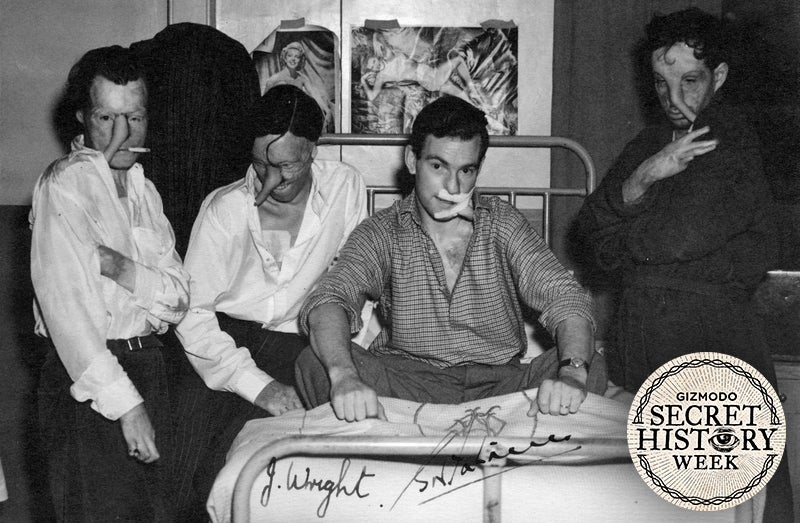
The Secret WWII Club That Healed Burned Pilots and Revolutionized Plastic Surgery
One of the most exclusive clubs in Great Britain is not full of hereditary peers and socialites, but instead counts former pilots and servicemen as its chief members. It’s called the Guinea Pig Club and membership dues are steep.
In order to join the Guinea Pig Club you had to have at least two reconstructive surgeries at Queen Victoria Cottage Hospital in East Grinstead, in the UK, by pioneering plastic surgeon Archibald McIndoe back in the 1940s. By the end of World War II there were 649 members, mostly from Great Britain, but also from Canada, Australia, New Zealand and the Czech Republic.
Before WWII, severe burns were rare and mostly due to household accidents. But the war changed that. Flying dangerous planes like the Spitfires and Hurricanes that were prone to accidents, full of highly flammable fuel that would spill over the pilots and crew, resulted in many otherwise healthy young men with disfiguring burns all over their bodies.
McIndoe, a native New Zealander, pioneered many of the treatment techniques still used today to treat severe burns. But he also recognized that to treat the trauma on the outside, you also have to treat the trauma on the inside. Thus the Guinea Pig Club was born.
Plastic surgery at the time was pretty crude. Even something as simple as how to best heal burns before reconstructive surgery could be attempted was a matter of trial and error. The prevailing wisdom at the time called for a special chemical coating usually applied to minor burns. It would form a protective layer to allow the burns to heal. But it proved disastrous for treating severe burns over large areas. The coating would dry out the skin, cause additional scarring, and was incredibly painful to remove. After trying the coating with little success, McIndoe observed that the burns of patients who had crashed into water would heal the fastest. So he started using saline baths for the burns instead to encourage healing.
When it came to reconstructing lips, noses and whole patches of skin on faces, more drastic measures were needed. A large sheet of skin taken from an unburned area like the thigh will not survive transplantation. McIndoe would carefully leave the skin flap attached at one end, roll it into a tube, stitch it up so there would be no infection, and attach it to another site closer to where he ultimately wanted it, like the arm. Once it had healed and started to draw its blood supply from the arm, he would detach it from the thigh and attach it from the arm to the face, where after it had healed, he could use it to reconstruct features. Patients had to walk around with their faces connected to their shoulders or arms by skin tubes that looked like little elephant trunks — but it worked. Large patches of skin survived and could be used to form new features.
Club member Bill Foxley endured 29 operations to rebuild his face. When his plane crashed he managed to make it out unharmed, but he ran back to the burning plane try to save the wireless operator who was still trapped inside. In his efforts to free him from the plane, Foxley was badly burned. (The wireless operator did not survive.)
One eye was destroyed, along with the skin, muscle and cartilage of his face up to his eyebrows; the cornea of the other eye was badly scarred. Foxley was never able to smile again because of the injuries. But that did not stop him from marrying one of his nurses at the hospital in 1947, or having a career after the war at the Central Electricity Generating Board. He developed a reputation for being hard on contractors when he would inspect their work by intensely studying it from a few inches away. The contractors never realized it was because he couldn’t see it otherwise.
Another patient, Sandy Saunders, was a glider pilot. When his plane crashed, he suffered burns on 40% of his body. His nose and eyelids had to be rebuilt. The experience inspired him to become a doctor. He would spend his recovery time between surgeries watching McIndoe operate on other patients, and dissecting frogs in preparation for his post-war career change.
One of the most remarkable things about the Guinea Pig Club was the attitude of the doctors and nurses. They didn’t treat them like invalids in recovery. The staff took pains to create a cheerful and normal environment at the hospital, and McIndoe overlooked the often inappropriate flirtations of the lonely young men with the nurses. One nurse recalled how a patient with badly burned hands still managed to pinch her when she turned around. When she threatened to punch him in the nose if he ever tried it again, he pointed out that he didn’t actually have a nose. “I can wait,” she dryly replied.
The club members had a dark sense of humor. When the club was first formed, they selected a pilot whose fingers were badly burned as the secretary so that he couldn’t take minutes, and another pilot with badly burned legs as the treasurer so he couldn’t run away with club money.
They were all very young, mostly around twenty years old. Some were suicidal when they arrived at the hospital. They had survived when their friends had died. They thought their lives were going to be over.
So McIndoe brought in showgirls to visit them from London to convince them that they could still talk to pretty girls. He got them invited to tea at the homes of local families so they felt welcomed. He let them wear their uniforms in the hospital. He kept plenty of beer on the floors. After all, the Guinea Pigs were technically a drinking club.
It was one of the first efforts to focus on both the physical and the psychological recovery of patients. Before then, people with disfiguring injuries or disabilities were often hidden from sight. Instead of casting the burned pilots and crew as unfortunate young men with their lives cut short, McIndoe presented them as heroes to be lauded for their courage. If a play was opening or a movie premiering in town, McIndoe got his patients invited as guests of honor.
And it worked. Grinstead, where the hospital was based, became known as “the town that did not stare.” A number of the club members married women they met in the town while recuperating.
The motivation to reintegrate the members of the Guinea Pig Club into society was not entirely altruistic. The Royal Air Force had spent a lot of time and money training the pilots and was eager for anything that could return them to active duty. Still, it was a big change in attitude for the military, according to Emily Mayhew, historian and author of The Reconstruction of Warriors.
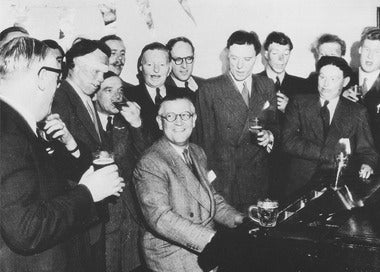
After the war, the former patients continued to meet for reunions. It was only in 2007, when the oldest member was 102 and the youngest 82 that they decided they were getting too old as a group to keep traveling to reunions. The Guinea Pig Club aptly demonstrates that the key to resilience is a little humor, social acceptance, and the knowledge that you are not alone.
Anony Mouse's Link
The history of inoculation may sound a little dry, but it’s really an epic tale of human trafficking, semi-illicit experimentation, and high explosives. It’s a globe-hopping story that stars harem girls, noblewomen, prisoners, princesses, slaves, and even a witch hunter.
(continued at link)

It’s not just paper. From the first notes issued by the Continental Congress to the latest star-spangled bills released by the Federal Reserve, the history of money in America is laced with rebellion, propaganda, and—of course—lots and lots of wealth. It’s awkwardly beautiful.
The history of paper currency, specifically, serves as a curious lens through which to understand the origins of this complicated nation. Like the government itself, money in America dates back to 1776 when the Continental Congress issued the country’s first official dollar bills. But before and well after that, it had been a free-for-all with any bank or state able to issue its own currency. It wasn’t until the 20th century that the nation’s currency would be standardized and even recognizable to present-day observers.
How we got here is a bit of a twisted tale.
(continued at link)

In the early morning hours on July 4th, 1986, 21-year-old Lance Corporal Howard A. Foote Jr. climbed a ladder leading into the cockpit of an A-4M Skyhawk. He started the jet up, taxied to one of Marine Corps Air Station El Toro’s runways—which was unlit at the time—and pushed the throttles forward. Moments later, the Lance Corporal would realize his dream to fly a tactical military jet, albeit just once and illegally.
Foote flew out toward San Clemente Island, executing loops, rolls and high-speed maneuvers before turning back to MCAS El Toro after about 45 minutes to attempt a landing. This time, the runways were all very well lit and the base was buzzing with activity due to his “borrowing” of the jet.
After several landing attempts, the Skyhawk maintainer put the A-4M down safely and was quickly detained after exiting the cockpit.
There was little doubt that the whole stunt was extremely dangerous, but it was also an amazing accomplishment although Foote was no novice to flying. He was an accomplished glider pilot who set world records at a very young age.
Just months prior to his Skyhawk caper, he tried to set a glider altitude record that resulted in an aerial embolism. Due to the nature of this injury, he was told he would never be able to fly for the military. The news crushed him, so he became a fast-jet pilot on his own terms just days later.
The path that got him flying a glider at 41,000 feet, which caused the embolism and eventually commandeering a Skyhawk, was a strange one. Foote befriended the Marine Crops general who commanded MCAS El Toro at a glider base in the Mojave Desert. The General was also a keen glider enthusiast, and Foote was a talented pilot with loads of potential.
The LA Times quotes the young Marine’s father as saying that the General’s influence on his son was not a positive thing:
“Bloomer was a glider pilot enthusiast, and they got to be real pals,” he said. “He got Buddy’s (Howard Foote’s Jr’s nickname) head all turned around, getting him special flying clothes and talking to him about what a real great flier he was and how he was just the person to set a new altitude record. . . . Buddy got hurt doing what the general wanted him to do.”
Apparently, the General Bloomer tried to get the altitude record flight to be a Marine Corps sanctioned event, but he could not get approval. A pressure suit would had likely been provided if he had, which would have made the attempt much safer.
Also speaking to the L.A. Times, the General reflected on what had happened.
“Buddy was a sterling Marine with an unblemished record who had done a lot of things that people a lot older could only dream about doing,” Bloomer said. “I regret that he screwed up a good career.”
The General continued apologetically, “I tried to discourage him because going above 30,000 feet without a pressure suit is dangerous. And he ended up going up to 41,000 feet before the bends forced him to come down.”
“I would encourage him to get a college education,” Bloomer said. “There are a lot of other things he can do in aviation besides being a fighter pilot. He could become an engineer or go into aircraft manufacturing.
“Buddy was a sterling Marine with an unblemished record who had done a lot of things that people a lot older could only dream about doing. I regret that he screwed up a good career.”
General Bloomer retired from his position as the head of MCAS El Toro just days before Foote stole the Skyhawk.
As for Howard Foote Jr’s perspective on the relationship, he states:
“Like Oliver North, I was given a job to do,” Foote said. “My job was to break [glider] records. Well, I went out and broke records and got hurt doing it. But when I needed a helping hand, none of the people in command would come forward and get me a medical waiver so I could fly [jets].”
Aside from his time in gliders, Foote was also said to have had about 100 hours of A-4 Skyhawk simulator time. With what he knew about the jet in order to maintain it, along with his strong natural flying skills, it was enough for him to pull off the late-night fantasy flight and live to talk about it.
Yet the jet used for the adventure, which belonged to VMA-214 “Black Sheep” at the time, was discovered to have been unsafe for flight. During testimony surrounding the case, it was noted that the jet’s ailerons were out of alignment and that its nose-gear steering was not working properly. Both factors that made Foote’s flight that much more dangerous.
A load of charges were brought against the Lance Corporal, including misappropriating the truck he used to get to the aircraft and the Skyhawk itself, as well as damaging an aircraft and disobeying regulations. He was also charged with hazarding a vessel, flying without proper training or approval and recklessly disregarding the plane’s mechanical condition at the time of flight.
Many of these charges were dropped, but Foote still could have faced nine years of hard labor, forfeiture of all pay, demotion to private and a dishonorable discharge. In the end, none of this occurred. Foote received 4 1/2 months already served in the brig, and an other-than-honorable discharge from the Marine Corps. It was a remarkably light sentence for such a dangerous and selfish act. But Foote had been a stellar Marine, with absolutely nothing on his record prior to show a pattern of misbehavior or irresponsibility. The General’s influence on him, and his injury in relation to it, was likely factored into the sentence.
After trying to apply to the Israeli Air Force to fly fighters, Howard Foote Jr. went on to become a civilian test pilot and engineer, working on various projects over the years, including a microwave airplane concept and projects for NASA.
Not bad for a guy who stole an operational fast jet from the Marine Corps.
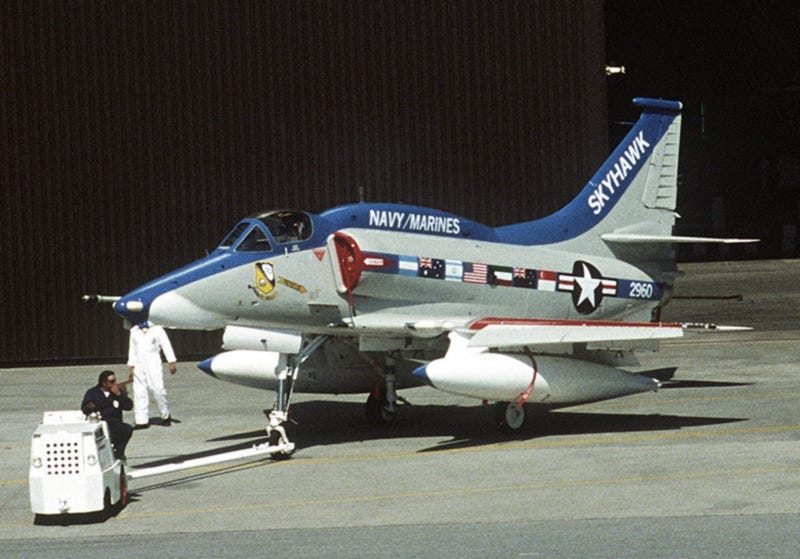
In the morning sun, I could not believe my eyes. There, in our little airport, sat a majestic P-51. They said it had flown in during the night from some U.S. Airport, on its way to an air show. The pilot had been tired, so he just happened to choose Kingston for his stop over. It was to take to the air very soon. I marveled at the size of the plane, dwarfing the Pipers and Canucks tied down by her. It was much larger than in the movies. She glistened in the sun like a bulwark of security from days gone by.
The pilot arrived by cab, paid the driver, and then stepped into the pilot's lounge. He was an older man; his wavy hair was gray and tossed. It looked like it might have been combed, say, around the turn of the century. His flight jacket was checked, creased and worn - it smelled old and genuine. Old Glory was prominently sewn to its shoulders. He projected a quiet air of proficiency and pride devoid of arrogance. He filed a quick flight plan to Montreal ("Expo-67 Air Show") then walked across the tarmac.
After taking several minutes to perform his walk-around check, the tall, lanky man returned to the flight lounge to ask if anyone would be available to stand by with fire extinguishers while he "flashed the old bird up, just to be safe." Though only 12 at the time I was allowed to stand by with an extinguisher after brief instruction on its use -- "If you see a fire, point, then pull this lever!", he said. (I later became a firefighter, but that's another story.) The air around the exhaust manifolds shimmered like a mirror from fuel fumes as the huge prop started to rotate. One manifold, then another, and yet another barked -- I stepped back with the others. In moments the Packard-built Merlin engine came to life with a thunderous roar. Blue flames knifed from her manifolds with an arrogant snarl. I looked at the others' faces; there was no concern. I lowered the bell of my extinguisher. One of the guys signaled to walk back to the lounge. We did.
Several minutes later we could hear the pilot doing his pre-flight run-up. He'd taxied to the end of runway 19, out of sight. All went quiet for several seconds. We ran to the second story deck to see if we could catch a glimpse of the P-51 as she started down the runway. We could not. There we stood, eyes fixed to a spot half way down 19. Then a roar ripped across the field, much louder than before. Like a furious hell spawn set loose -- something mighty this way was coming. "Listen to that thing!" said the controller.
In seconds the Mustang burst into our line of sight. It's tail was already off the runway and it was moving faster than anything I'd ever seen by that point on 19. Two-thirds the way down 19 the Mustang was airborne with her gear going up. The prop tips were supersonic. We clasped our ears as the Mustang climbed hellishly fast into the circuit to be eaten up by the dog-day haze. We stood for a few moments, in stunned silence, trying to digest what we'd just seen. The radio controller rushed by me to the radio. "Kingston tower calling Mustang?" He looked back to us as he waited for an acknowledgment. The radio crackled, "Go ahead, Kingston." "Roger, Mustang. Kingston tower would like to advise the circuit is clear for a low level pass." I stood in shock because the controller had just, more or less, asked the pilot to return for an impromptu air show! The controller looked at us. "Well, What?" He asked. "I can't let that guy go without asking. I couldn't forgive myself!"
The radio crackled once again, "Kingston, do I have permission for a low level pass, east to west, across the field?" "Roger, Mustang, the circuit is clear for an east to west pass." "Roger, Kingston, I'm coming out of 3,000 feet, stand by." We rushed back onto the second-story deck, eyes fixed toward the eastern haze. The sound was subtle at first, a high-pitched whine, a muffled screech, a distant scream. Moments later the P-51 burst through the haze. Her airframe straining against positive G's and gravity. Her wing tips spilling contrails of condensed air, prop-tips again supersonic. The burnished bird blasted across the eastern margin of the field shredding and tearing the air. At about 500 mph and 150 yards from where we stood she passed with the old American pilot saluting. Imagine. A salute! I felt like laughing; I felt like crying; she glistened; she screamed; the building shook; my heart pounded. Then the old pilot pulled her up and rolled, and rolled, and rolled out of sight into the broken clouds and indelible into my memory.
I've never wanted to be an American more than on that day! It was a time when many nations in the world looked to America as their big brother. A steady and even-handed beacon of security who navigated difficult political water with grace and style; not unlike the old American pilot who'd just flown into my memory. He was proud, not arrogant, humble, not a braggart, old and honest, projecting an aura of America at its best.
That America will return one day! I know it will! Until that time, I'll just send off this story. Call it a loving reciprocal salute to a Country, and especially to that old American pilot: the late-JIMMY STEWART (1908-1997), Actor, real WWII Hero (Commander of a US Army Air Force Bomber Wing stationed in England), and a USAF Reserves Brigadier General, who wove a wonderfully fantastic memory for a young Canadian boy that's lasted a lifetime.
Master Sgt. Roddie Edmonds – a Righteous Among the Nations
“We are all Jews here”

AP Reports:
The Nazi soldiers made their orders very clear: Jewish American prisoners of war were to be separated from their fellow brothers in arms and sent to an uncertain fate.
But Master Sgt. Roddie Edmonds would have none of that. As the highest-ranking noncommissioned officer held in the German POW camp, he ordered more than 1,000 Americans captives to step forward with him and brazenly pronounced: “We are all Jews here.”
He would not waver, even with a pistol to his head, and his captors eventually backed down.
Seventy years later, the Knoxville, Tennessee, native is being posthumously recognized with Israel’s highest honor for non-Jews who risked their lives to save Jews during World War II. He’s the first American serviceman to earn the honor.
The Yad Vashem news release explains further:
When the German camp commander, Major Siegmann, saw that all the camp’s inmates were standing in front of their barracks, he turned to Edmonds and exclaimed: “They cannot all be Jews!” To this Edmonds replied: “We are all Jews.” Siegmann took out his pistol and threatened Edmonds, but the Master Sergeant did not waver and retorted: “According to the Geneva Convention, we only have to give our name, rank and serial number. If you shoot me, you will have to shoot all of us, and after the war you will be tried for war crimes.” The Commandant turned around and left the scene. NCO Paul Stern retold this encounter to Yad Vashem. Stern, one of the Jewish POWs rescued by Edmonds, told Yad Vashem that he was taken prisoner on December 17, 1944, during the Battle of the Bulge. “Stern stood very close to Edmonds during the exchange with the German camp commander, which, he later recalled was conducted in English. “Although seventy years have passed,” said Stern, “I can still hear the words he said to the German Camp Commander.” …
Master Sergeant Roddie Edmonds passed away in 1985. In 2015, Yad Vashem posthumously recognized Edmonds as Righteous Among the Nations. He is the first American soldier, and only one of five Americans, to be recognized by Yad Vashem as Righteous Among the Nations, alongside Varian Fry, Waitstill and Martha Sharp, and Lois Gunden. To date, more than 26,000 individuals have received the honor.
God Bless him.
BADASS HISTORICAL CHEMISTS: ALICE HAMILTON VERSUS ABSOLUTELY EVERYONE
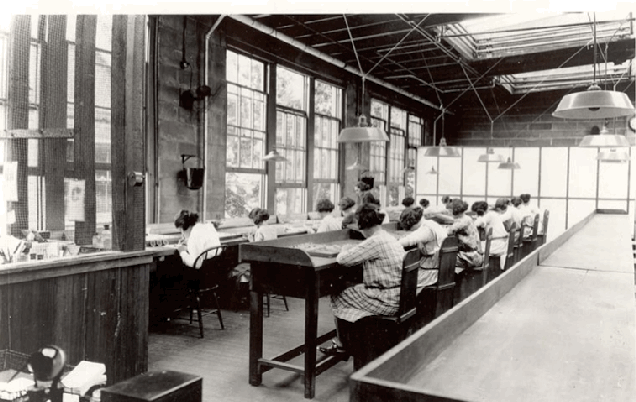
Alice Hamilton was one of those people who used science to shape morality. Basic concepts like sanitation, worker safety, and proper chemical disposal exist because she proved there was no other choice. She was also one of the first to speak out about the growing threat of Nazi Germany.
Technically a biochemist, Hamilton is a science all-star who deserves to be far more famous than she is. She was smart enough to be the first woman to be appointed an assistant professor at Harvard Medical School, and outspoken enough to be nearly thrown out multiple times during her multi-decade career. Once, she put cocaine in her own eyeballs to prove to juries that drug dealers were trying to sell the white powder to school children. But she spent most of her career decrying her own most famous experiment.
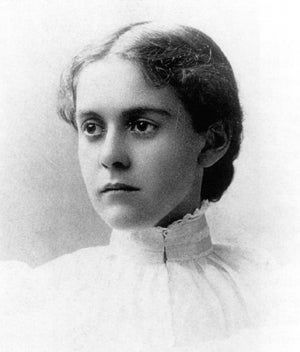
When she’d worked in Chicago during a typhoid epidemic, she’d shown that flies could carry typhoid between overloaded, filthy communal privies and cramped kitchens without window screens. Her work helped kickstart laws meant to keep landlords from stinting on sanitation or overcrowding their buildings.
Yet Hamilton later found out that her experiment, while correctly done, did not reveal the source of the epidemic. A sewer line had burst and the city had covered it up. Whenever anyone credited her with solving the mystery of the typhoid epidemic—often at the beginning of a speech—she would immediate correct them. She was the first to speak out against herself.
She was the first to speak out against nearly anything. She helped prove that radium was poisoning watch-painters (so-called “radium girls”). She helped prove that carbon monoxide was poisoning steel workers. She helped prove that mercury was poisoning hatters. She helped prove that excessive use of jackhammers caused “dead fingers” in construction workers. And she helped show that making lead pigment was bad for workers, especially child workers. Most importantly, she spoke publicly and loudly about what she had proved. The most basic worker’s safety concepts were pioneered by Alice Hamilton.

During her college years she’d traveled to Germany with her sister. After World War I, she went back, returning home to rally people to provide food for the starving Germans. Hamilton had been against entry into World War I, considering pro-war stances militaristic and useless. Many Americans were not impressed with the fact that the person who nagged them about staying out of Germany was asking for aid for the people who had been killing American soldiers. Pressure mounted on Harvard to terminate her professorship, which, to their credit, they did not.
Germany recovered. Hamilton went back. And she came back with even more complaints, which also proved to be justified. In 1933, she wrote widely about the rise of the Nazi party, decrying its antisemitism and militarism, and noting the party’s particular appeal to youth culture.
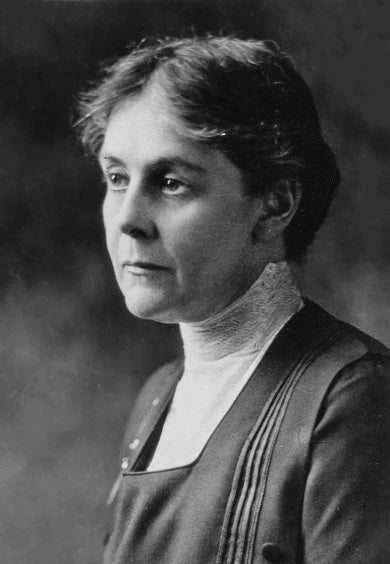
She also wrote about something many social crusaders of her time neglected. Hamilton had worked all her life, in government and in academia, and her German counterparts were getting fired from both spheres. Nazi policy promoted the concept of motherhood above all else. Hamilton pointed out that this wasn’t just sexism, it was a power grab. Every non-Nazi German woman who they kicked out of a position made way for a Nazi sympathizer who could help solidify their hold on public institutions.
Hamilton also was one of the rare academics who managed to study different classes. Having spent her life studying the working class, she wrote about the Nazi policy of sending working class women home—and correctly predicted that it wouldn’t work because, ideals or not, the country needed the labor.
Alas, she didn’t have the clout to stop the Nazis. (How cool a story would this be if she did?) What she did have was connections and drive, and so for most of the 1930s, she provided what help she could to people fleeing Germany.
Hamilton continued being a loud pain in the ass well into the 1960s. She argued that the paranoia about the Cold War was taking away American liberties. She fought against the propping up of anti-Communist regimes. She lobbied for the Civil Rights Amendment. (At first she’d been against it, believing it would take away workplace protections for women.) She was on the FBI watch list into her nineties.
Hamilton died in 1970, age 101, having spent her life being supremely useful to humanity and making pretty much all the right enemies.
Images: (top) “Radium girls” working in a US factory. Public domain. (middle and bottom) Alice Hamilton, young and old. Public domain.
One of the more relevant pics from the link to this site ;o)
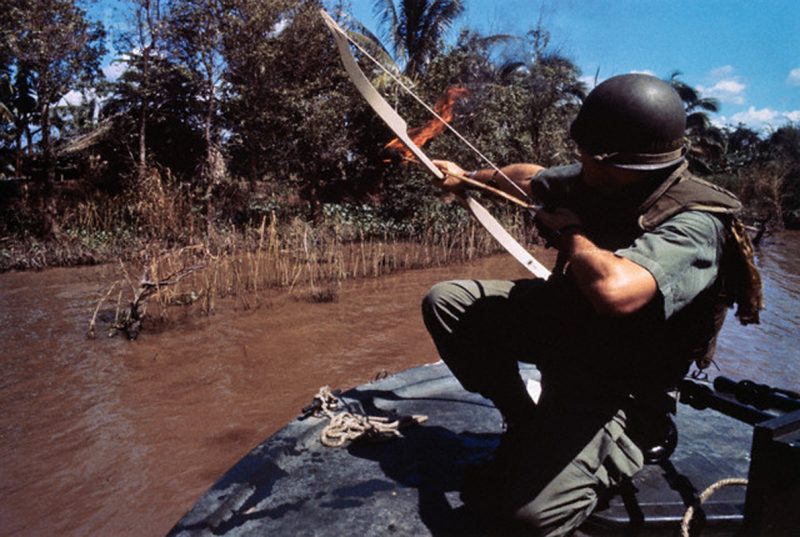
Right! Parachuted Out of His Crippled B-24 & Killed the Zero Pilot With A Head Shot From His M1911
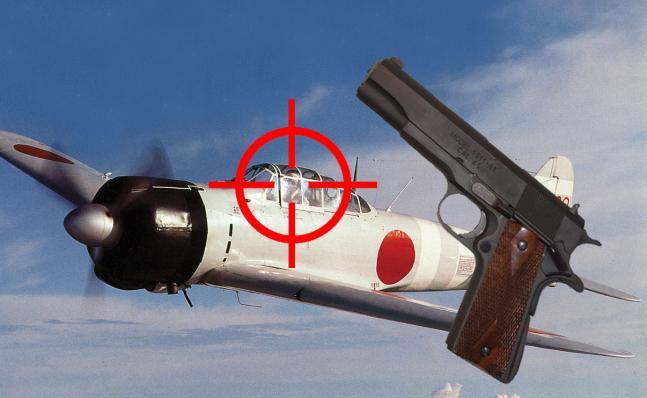
In the hands of American soldiers and marines, the M1911A1 performed admirably throughout World War II. In fact, there are numerous accounts of the Colt M1911 being used in courageous acts earning the bearer the Medal of Honor.
There are also legends about the power, accuracy and reliability of Browning’s masterpiece, which may, or may not, be true, but speak to the magnificence of a pistol design that is more than 100 years old. One of these stories took place March 31, 1943, near Pyinmana, Myanma, and was first reported July 1996 in “Air Force Magazine.”
On that fated day, the 7th BG’s 9th Bomb Squadron was sent on a mission to destroy a railroad bridge but was attacked before it could reach its target. The bombing group took heavy fire from Japanese fighter planes, wounding the squadron’s commander, Col. Conrad F. Necrason, and disabling numerous B-24 Bombers, including one carrying Lt. Owen J. Baggett.
Though the crew continued to fight, it was obvious that the plane was going to crash, so Baggett’s pilot, Lt. Lloyd Jensen, ordered the men to bail out. Along with the other members of his unit, Baggett jumped from the plane and pulled his parachute.
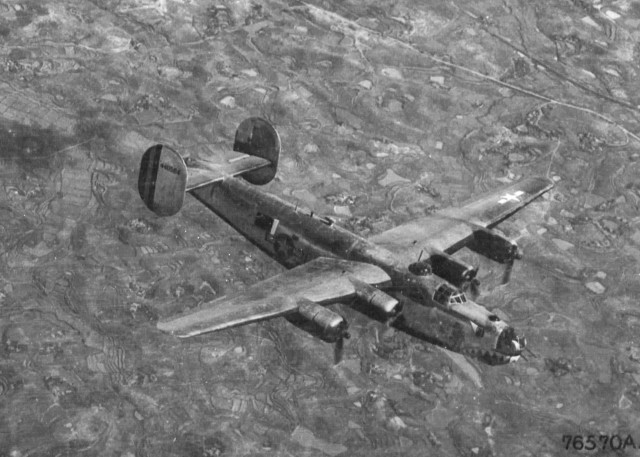 A B-24 Bomber flying over China during WW2. (Wikipedia)
A B-24 Bomber flying over China during WW2. (Wikipedia)
The Japanese pilots fired on the floating crew killing some and wounding Lt. Baggett in the arm. The story goes that when the pilot who fired upon Baggett came around for a look, the young lieutenant hung limply in his harness as if dead. The ruse worked because the fighter raised his canopy as he flew within feet of the parachute giving Baggett an opportunity. As the plane soared by, Baggett raised his M1911A1 .45 and fired four rounds at the aircraft, which banked before stalling and crashing into the ground.
After landing on the ground, Lt. Baggett, along with three other crew members, was captured and taken to a POW camp near Singapore. Baggett didn’t believe that he had taken down a fighter plane with only a handgun. However, Col. Harry Melton, commander of the 311th Fighter Group, ended up at the same camp telling a story about a Japanese colonel that had said that the pilot Baggett had fired upon had been thrown clear of the plane and had been found dead of a single bullet to the head.
While there is no direct evidence that Lt. Owen Baggett did, in fact, take down a Japanese fighter plane with a handgun, many believe it to be true. Regardless, this is a great story of a courageous man involving a legendary pistol.
After the end of World War II, Owen Baggett remained in the military eventually rising to the rank of colonel in the U.S. Air Force, which was his rank when he retired to San Antonio, Texas.
In 2006, at 85 years old, Owen Baggett died in Texas, but he will always be remembered as the man who used a .45 to get a Zero.
Mysterious Bluesman, Robert Johnson, Identified in Rare 80-Year-Old Photo
(Note: some internal links at article)
Robert Johnson stands as the enigmatic figure at the genesis of American popular music. Dead at age 27 in 1938, legend has it Johnson cut a deal with the devil at a Mississippi crossroads to become the greatest blues guitarist in exchange for a young death – and his soul. Only two grainy pictures have been confirmed as legitimate images of the bluesman.
A noted forensic artist has now confirmed a picture found in the drawer of a desk acquired at an auction is now the third surviving image of one of the most important American artists of all time, reports The Houston Chronicle.
The desk was brought in 2013 by a lawyer in Florida. In one of its cluttered drawers, the owner found a three-by-five-inch photo showing four people sitting around a table. The quartet look bored; three aren’t looking at the camera. A man on the left, thought to be Johnson himself, has a glass raised to his mouth, his eyes staring into the camera. But he has a distinctive bowler hat, which has been identified with Johnson in other images and depictions.
The owner didn’t do anything for two years – but eventually reached out to Lois Gibson, who has been described as the “world’s most successful forensic artist.”
The Texas-based forensic expert recognized the face using her expertise in comparing the known photos of pictures, one of which she had previously identified in 2008. Additional evidence was in the people sitting with the man: they were identified as Johnson’s wife, the woman who was Johnson’s landlord, and her son.
The Chronicle cited several blues scholars’ doubts of the authenticity of the new photo. But Gibson reportedly dismissed those experts, saying that she alone was trained in facial structure and other technical aspects of anatomy.
Johnson only sat for two recording sessions in 1936 and 1937. The 29 songs totaled just over a single hour of music. But that single hour essentially changed the direction of blues music – and paved the way for rock and roll, according to many experts.
Johnson died in Mississippi in 1938 and most accounts claim he was poisoned by a jealous husband.
As for the devil legend, Johnson seemed to confirm it through much of his lyrics, like in the song, “Me and the Devil Blues”:
“Early this mornin', ooh / When you knocked upon my door / And I said, ‘Hello, Satan’ / I believe it's time to go / Me and the Devil / was walkin' side by side,” Johnson sang.
To view the original photograph, click here. (worth clicking!)
bad karma's Link
CELEBRATE THE 51ST ANNIVERSARY OF THE SR-71 BLACKBIRD'S FIRST FLIGHT WITH THESE CRAZY STATS

On December 22nd, 1964, the SR-71 Blackbird took to the air for the very first time, rising above Air Force Plant 42 in Palmdale with F-104 chase planes in pursuit. The occasion would mark the birth of one of the most amazing and renowned aircraft of all time. To understand just how exotic the Blackbird family of aircraft were, you need look no farther than its historical stats and metrics.
Some numbers from the Blackbird family of planes:
35 miles per minute or 3,100 feet per second is how fast the SR-71 could fly
170,000 pounds was how much a fully fueled and outfitted Blackbird weighed
59,000 pounds was what one weighed empty
107 feet, 5 inches is the length of a Blackbird
85,000 feet is the official Blackbird ceiling, although it supposedly could fly higher
34,000 pounds of thrust were what each of the SR-71’s J-58 engines put out in afterburner
17,300 total sorties were flown by the Blackbird family of aircraft
3,551 of these sorties were operational missions
11,675 hours were spent over mach three
53,490 total flight hours were amassed on the fleet
Just 8 crew members had more than 1,000 hours in the jet
Only 86 SR-71 pilots and 86 RSOs flew operational missions
385 total persons have reached mach three in a Blackbird, including 105 VIPs
478 total people have flown in Blackbirds
32 SR-71s were built
50 total Blackbird family aircraft were built (A-12, YF-12, SR-71, M-21)
1 hour and 4 minutes was how fast the SR-71 could go from Los Angeles to Washington D.C.
$33,000,000 was the cost to build a single SR-71 Blackbird
900 degrees Fahrenheit was how hot the SR-71’s skin got during high-speed runs
3,200 degrees Fahrenheit was the temperature of the J-58 engine’s exhaust at maximum output
Over 1,000 missiles were launched at the SR-71 without any losses
5 pounds is how much weight a SR-71 crew member could lose in their pressure suit during a four our mission
85 percent of the Blackbird’s skin is titanium, the other 15 percent is carbon composites
2.5G was the SR-71’s structural stress limit
About 16 “starts” per engine worth of Triethylborane (TEB) were carried on an SR-71 mission as the Blackbird’s engines could not be restarted in the air without the TEB accelerant.
140 degrees Fahrenheit was the flash-point of the SR-71’s JP-7 fuel. Normal jet fuel has a flash-point of 100 degrees Fahrenheit.
56 KC-135s were converted to KC-135Q/Ts that could refuel Blackbirds
20 of the 50 Blackbird aircraft family were written off in crashes and mishaps
6 inches is how much longer the SR-71 would grow at high speed due to heat expansion
Zero was the number of computers used to design the Blackbird
Here’s to the “Sled” at 51 one years of age!
Sources: SR71Websmaster, SR-71.org, SR-71: The Complete Illustrated History of the Blackbird, HABU.org
The Very American History of Christmas Lights

The Real Story Behind the 1914 Christmas Truce in World War I
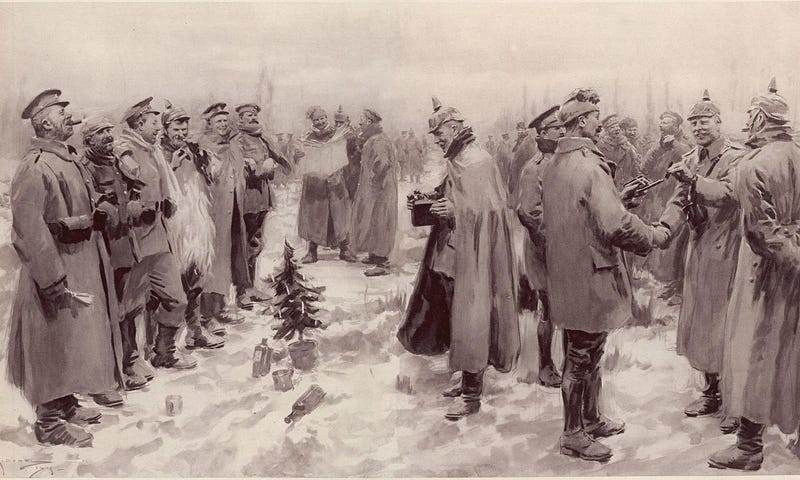
It was 101 years ago this very night that something miraculous happened along the Western Front. After months of bitter fighting, soldiers on both sides gathered in no-man’s-land in a spontaneous show of peace and goodwill. Here’s what happened on that historic day — and why it marked the end of an era.
*Sometimes , it’s not really just luck.*
USA – -(Ammoland.com)- This story is confirmed in Elmer Bendiner’s book, ‘The Fall of Fortresses.’

Elmer Bendiner was a navigator in a B-17 during WW II. He tells this story of a World War II bombing run over Kassel, Germany , and the unexpected result of a direct hit on their gas tanks.
“Our B-17, the Tondelayo, was barraged by flak from Nazi antiaircraft guns. That was not unusual, but on this particular occasion our gas tanks were hit.”
Later, as I reflected on the miracle of a 20 millimeter shell piercing the fuel tank without touching off an explosion, our pilot, Bohn Fawkes, told me it was not quite that simple. On the morning following the raid, Bohn had gone down to ask our crew chief for that shell as a souvenir of unbelievable luck.
The crew chief told Bohn that not just one shell but eleven (11) had been found in the gas tanks. Eleven unexploded shells, where only one was sufficient to blast us out of the sky.
It was as if the sea had been parted for us. A near-miracle, I thought.
Even after 35 years, so awesome an event leaves me shaken, especially after I heard the rest of the story from Bohn.
“He was told that the shells had been sent to the armorers to be defused. The armorers told him that Intelligence had picked them up. They could not say why at the time, but Bohn eventually sought out the answer. “Apparently when the armorers opened each of those shells, they found no explosive charge. They were as clean as a whistle and just as harmless.
Empty? Not all of them! One contained a carefully rolled piece of paper. On it was a scrawl in Czech. The Intelligence people scoured our base for a man who could read Czech. Eventually they found one to decipher the note. It set us marveling. Translated, the note read:
*”This is all we can do for you now…Using Jewish slave labor is never a good idea.”
About The Fall Of Fortresses
The Fall Of Fortresses is a personal account of the most daring–and deadly – – American air battles of World War II: The bombing, August, 1943, of the ball-bearing factories at Schweinfurt, Germany. Copies are still available on Amazon : http://tiny.cc/32j28x
USSBarb: the sub that sank a tank
In 1973 an Italian submarine named Enrique Tazzoli was sold for a paltry $100,000 as scrap metal. The submarine, given to the Italian Navy in 1953 was actually an incredible veteran of World War II service with a heritage that never should have passed so unnoticed into the graveyards of the metal recyclers. The U.S.S. Barb was a pioneer, paving the way for the first submarine launched missiles and flying a battle flag unlike that of any other ship. In addition to the Medal of Honor ribbon at the top of the flag identifying the heroism of its captain, Commander Eugene "Lucky" Fluckey, the bottom border of the flag bore the image of a Japanese locomotive. The U.S.S. Barb was indeed, the submarine that "SANK A TRAIN".
July, 1945 (Guam)
Fleet Admiral Chester Nimitz looked across the desk at Admiral Lockwood as he finished the personal briefing on U.S. war ships in the vicinity of the northern coastal areas of Hokkaido, Japan. "Well, Chester, there's only the Barb there, and probably no word until the patrol is finished. You remember Gene Fluckey?"
"Of course. I recommended him for the Medal of Honor," Admiral Nimitz replied. "You surely pulled him from command after he received it?"
July 18, 1945 (Patience Bay, Off the coast of Karafuto, Japan)
It was after 4 A.M. and Commander Fluckey rubbed his eyes as he peered over the map spread before him. It was the twelfth war patrol of the Barb, the fifth under Commander Fluckey. He should have turned command over to another skipper after four patrols, but had managed to strike a deal with Admiral Lockwood to make one more trip with the men he cared for like a father, should his fourth patrol be successful. Of course, no one suspected when he had struck that deal prior to his fourth and what should have been his final war patrol on the Barb, that Commander Fluckey's success would be so great he would be awarded the Medal of Honor.
Commander Fluckey smiled as he remembered that patrol. "Lucky" Fluckey they called him. On January 8th the Barb had emerged victorious from a running two-hour night battle after sinking a large enemy ammunition ship. Two weeks later in Mamkwan Harbor he found the "mother-lode"...more than 30 enemy ships. In only 5 fathoms (30 feet) of water his crew had unleashed the sub's forward torpedoes, then turned and fired four from the stern. As he pushed the Barb to the full limit of its speed through the dangerous waters in a daring withdrawal to the open sea, he recorded eight direct hits on six enemy ships. Then, on the return home he added yet another Japanese freighter to the tally for the Barb's eleventh patrol, a score that exceeded even the number of that patrol.
What could possibly be left for the Commander to accomplish who, just three months earlier had been in Washington, DC to receive the Medal of Honor? He smiled to himself as he looked again at the map showing the rail line that ran along the enemy coast line. This final patrol had been promised as the Barb's "graduation patrol" and he and his crew had cooked up an unusual finale. Since the 8th of June they had harassed the enemy, destroying the enemy supplies and coastal fortifications with the first submarine launched rocket attacks. Now his crew was buzzing excitedly about bagging a train.
The rail line itself wouldn't be a problem. A shore patrol could go ashore under cover of darkness to plant the explosives...one of the sub's 55-pound scuttling charges. But this early morning Lucky Fluckey and his officers were puzzling over how they could blow not only the rails, but one of the frequent trains that shuttled supplies to equip the Japanese war machine. Such a daring feat could handicap the enemy's war effort for several days, a week, perhaps even longer. It was a crazy idea, just the kind of operation "Lucky" Fluckey had become famous...or infamous...for. But no matter how crazy the idea might have sounded, the Barb's skipper would not risk the lives of his men. Thus the problem... how to detonate the charge at the moment the train passed, without endangering the life of a shore party. PROBLEM? Not on Commander Fluckey's ship. His philosophy had always been "We don't have problems, only solutions".
11:27 AM
"Battle Stations!" No more time to seek solutions or to ponder blowing up a train. The approach of a Japanese freighter with a frigate escort demands traditional submarine warfare. By noon the frigate is laying on the ocean floor in pieces and the Barb is in danger of becoming the hunted.
6:07 PM
Solutions! If you don't look for them, you'll never find them. And even then, sometimes they arrive in the most unusual fashion. Cruising slowly beneath the surface to evade the enemy plane now circling overhead, the monotony is broken with an exciting new idea. Instead of having a crewman on shore to trigger explosives to blow both rail and a passing train, why not let the train BLOW ITSELF up. Billy Hatfield was excitedly explaining how he had cracked nuts on the railroad tracks as a kid, placing the nuts between two ties so the sagging of the rail under the weight of a train would break them open. "Just like cracking walnuts," he explained. "To complete the circuit (detonating the 55-pound charge) we hook in a microswitch ...between two ties. We don't set it off, the TRAIN does." Not only did Hatfield have the plan, he wanted to be part of the volunteer shore party.
The solution found, there was no shortage of volunteers, all that was needed was the proper weather...a little cloud cover to darken the moon for the mission ashore. Lucky Fluckey established his own criteria for the volunteer party:
...No married men would be included, except for Hatfield,
...The party would include members from each department,
...The opportunity would be split between regular Navy and Navy Reserve sailors,
...At least half of the men had to have been Boy Scouts, experienced in how to handle themselves in medical emergencies and in the woods.
FINALLY, "Lucky" Fluckey would lead the saboteurs himself.
When the names of the 8 selected sailors was announced it was greeted with a mixture of excitement and disappointment. Among the disappointed was Commander Fluckey who surrendered his opportunity at the insistence of his officers that "as commander he belonged with the Barb," coupled with the threat from one that "I swear I'll send a message to ComSubPac if you attempt this (joining the shore party himself)." Even a Japanese POW being held on the Barb wanted to go, promising not to try to escape.
In the meantime, there would be no more harassment of Japanese shipping or shore operations by the Barb until the train mission had been accomplished. The crew would "lay low", prepare their equipment, train, and wait for the weather.
July 22, 1945 (Patience Bay, Off the coast of Karafuto, Japan)
Patience Bay was wearing thin the patience of Commander Fluckey and his innovative crew. Everything was ready. In the four days the saboteurs had anxiously watched the skies for cloud cover, the inventive crew of the Barb had built their microswitch. When the need was posed for a pick and shovel to bury the explosive charge and batteries, the Barb's engineers had cut up steel plates in the lower flats of an engine room, then bent and welded them to create the needed tools. The only things beyond their control was the weather....and time. Only five days remained in the Barb's patrol.
Anxiously watching the skies, Commander Fluckey noticed plumes of cirrus clouds, then white stratus capping the mountain peaks ashore. A cloud cover was building to hide the three-quarters moon. This would be the night.
MIDNIGHT, July 23, 1945
The Barb had crept within 950 yards of the shoreline. If it was somehow seen from the shore it would probably be mistaken for a schooner or Japanese patrol boat. No one would suspect an American submarine so close to shore or in such shallow water. Slowly the small boats were lowered to the water and the 8 saboteurs began paddling toward the enemy beach. Twenty-five minutes later they pulled the boats ashore and walked on the surface of the Japanese homeland. Having lost their points of navigation, the saboteurs landed near the backyard of a house. Fortunately the residents had no dogs, though the sight of human AND dog's tracks in the sand along the beach alerted the brave sailors to the potential for unexpected danger.
Stumbling through noisy waist-high grasses, crossing a highway and then stumbling into a 4-foot drainage ditch, the saboteurs made their way to the railroad tracks. Three men were posted as guards, Markuson assigned to examine a nearby water tower. The Barb's auxiliary man climbed the ladder, then stopped in shock as he realized it was an enemy lookout tower....an OCCUPIED tower. Fortunately the Japanese sentry was peacefully sleeping and Markuson was able to quietly withdraw and warn his raiding party.
The news from Markuson caused the men digging the placement for the explosive charge to continue their work more slowly and quietly. Suddenly, from less than 80 yards away, an express train was bearing down on them. The appearance was a surprise, it hadn't occured to the crew during the planning for the mission that there might be a night train. When at last it passed, the brave but nervous sailors extracated themselves from the brush into which they had lept, to continue their task. Twenty minutes later the holes had been dug and the explosives and batteries hidden beneath fresh soil.
During planning for the mission the saboteurs had been told that, with the explosives in place, all would retreat a safe distance while Hatfield made the final connection. If the sailor who had once cracked walnuts on the railroad tracks slipped during this final, dangerous proceedure, his would be the only life lost. On this night it was the only order the saboteurs refused to obey, all of them peering anxiously over Hatfield's shoulder to make sure he did it right. The men had come too far to be disappointed by a switch failure.
1:32 A.M. Watching from the deck of the Barb, Commander Fluckey allowed himself a sigh of relief as he noticed the flashlight signal from the beach announcing the departure of the shore party. He had skillfully, and daringly, guided the Barb within 600 yards of the enemy beach. There was less than 6 feet of water beneath the sub's keel, but Fluckey wanted to be close in case trouble arose and a daring rescue of his saboteurs became necessary.
1:45 A.M. The two boats carring his saboteurs were only halfway back to the Barb when the sub's machinegunner yelled, "CAPTAIN! Another train coming up the tracks!" The Commander grabbed a megaphone and yelled through the night, "Paddle like the devil!", knowing full well that they wouldn't reach the Barb before the train hit the microswitch.
1:47 A.M. The darkness was shattered by brilliant light and the roar of the explosion. The boilers of the locomotive blew, shattered pieces of the engine blowing 200 feet into the air. Behind it the cars began to accordian into each other, bursting into flame and adding to the magnificent fireworks display. Five minutes later the saboteurs we lifted to the deck by their exuberant comrades as the Barb turned to slip back to safer waters. Moving at only two knots, it would be a while before the Barb was into waters deep enough to allow it to submerge. It was a moment to savor, the culmination of teamwork, ingenuity and daring by the Commander and all his crew. "Lucky" Fluckey's voice came over the intercom. "All hands below deck not absolutely needed to maneuver the ship have permission to come topside." He didn't have to repeat the invitation. Hatches sprang open as the proud sailors of the Barb gathered on her decks to proudly watch the distant fireworks display. The Barb had "sunk" a Japanese TRAIN!
On August 2, 1945 the Barb arrived at Midway, her twelfth war patrol concluded. Meanwhile United States military commanders had pondered the prospect of an armed assault on the Japanese homeland. Military tacticians estimated such an invasion would cost more than a million American casualties. Instead of such a costly armed offensive to end the war, on August 6th the B-29 bomber Enola Gay dropped a single atomic bomb on the city of Hiroshima, Japan. A second such bomb, unleashed 4 days later on Nagasaki, Japan, caused Japan to agree to surrender terms on August 15th. On September 2, 1945 in Tokyo Harbor the documents ending the war in the Pacific were signed.
The story of the saboteurs of the U.S.S. Barb is one of those unique, little known stories of World War II. It becomes increasingly important when one realizes that the 8 sailors who blew up the train at near Kashiho, Japan conducted the ONLY GROUND COMBAT OPERATION on the Japanese "homeland" of World War II.

The eight saboteurs were: (L to R)
Paul Saunders, William Hatfield, Francis Sever, Lawrence Newland, Edward Klinglesmith, James Richard, John Markuson, and William Walker.
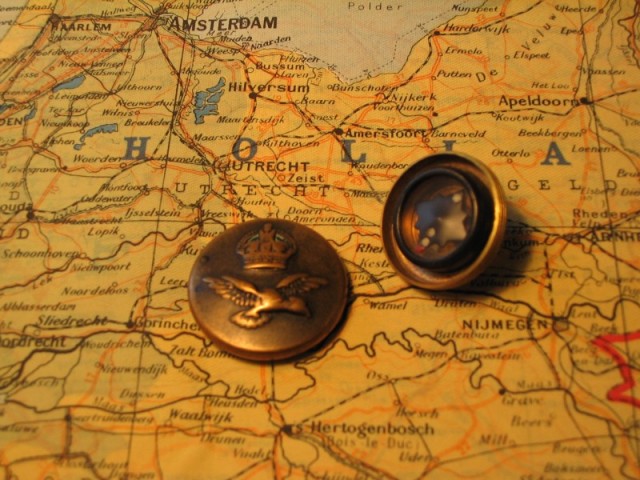 Button On New Shirt Hid A Compass For POWs
Button On New Shirt Hid A Compass For POWs
The Germans were surprised at how many Russian POWs they had in such a short interval of time. Almost 3,000,000 people suddenly fell into their responsibility in just four months after Barbarossa. Like the Japanese and in fact just like the Russians, POWs were first captured, then they were marched on foot back to a labor camp. During Japan’s Bataan Death March, 17,000 men died at one rest stop.
It was in 1929 that the Geneva Convention at the League of Nations where international POW treatment standards were established. Prisoners were to be kept in surroundings and in care as comfortable as the guards. And no torture was allowed. Japan and Germany declined to sign the agreement. The United States did not death march its prisoners back during the war. No. Instead our Axis prisoners were treated to cigarettes and coffee and food and kept in decent clothes as we transported them back to the mainland United States where they were housed in almost 200 camps all across the country.
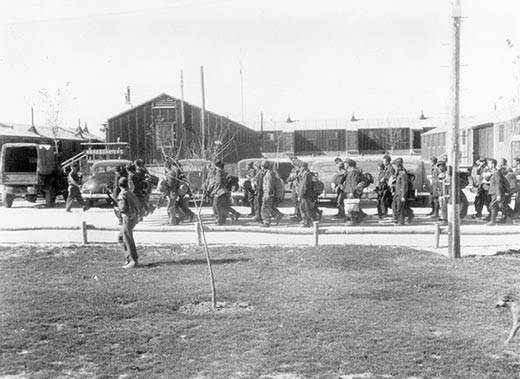
We took and kept 425,000 POWs during the course of the war.
The Japanese were particularly vicious and negligent with POWS. 16,000 Allied POWs died in Japanese custody and the rest were human skeletons. They probably killed 100,000 forced labor, particularly Chinese. Of the 50,000 British POWs 12,500 died in Japanese custody.
The Allied POWs were held in Germany, Italy, and Poland. Among US POWs were British, New Zealanders, Australians and Canadians.
POWs who weren’t mistreated suffered the harsh monotony of everyday life held in a small area and allowed to do things only permission was granted. For many it was broken up with Poker and Chess and Checkers.
The Germans allowed Red Cross packages to be delivered to Allied POWs. Inside Monopoly boards were often found maps out of the camp. In fact, Monopoly boards with intelligence like faked travel documents had a red dot printed in the Free Parking space. Inside the clothing donated to POWs were maps sewn into silk inside the shirt. Letters home were filled with codes based on character placement in sentences. Corks, and lighters also had maps and coded messages loaded in them to inform prisoner how to egress. So the communication between Allied intelligence and POWs was quite robust.
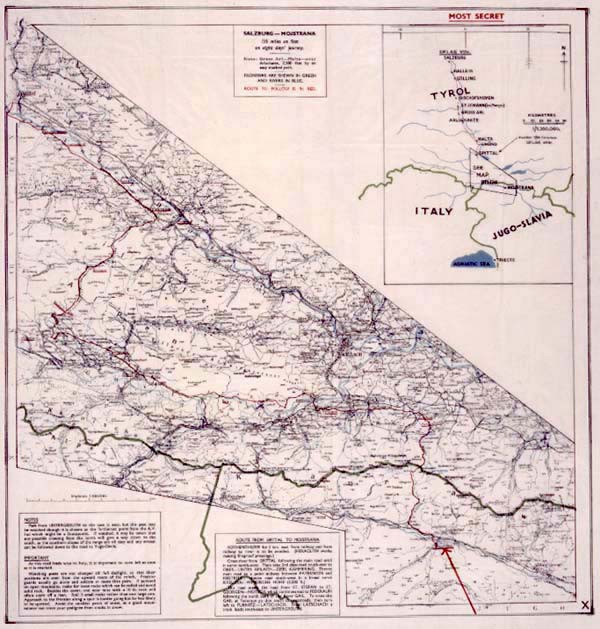 Map Smuggled Into POWs In A Game
Map Smuggled Into POWs In A Game
Many Allied POWs knew which way to run because of the maps and data hidden in these care packages. Yes, Get Out Of Jail Free.
By J. Malcolm Garcia in Smithsonian Magazine wrote in 2009 about people who grew up and saw them:
About 12,000 POWs were held in camps in Nebraska. “They worked across the road from us, about 10 or 11 in 1943,” recalled Kelly Holthus, 76, of York, Nebraska. “They stacked hay. Worked in the sugar beet fields. Did any chores. There was such a shortage of labor.”
“A lot of them were stone masons,” said Keith Buss, 78, who lives in Kansas and remembers four POWs arriving at his family’s farm in 1943. “They built us a concrete garage. No level, just nail and string to line the building up. It’s still up today.”
Don Kerr, 86, delivered milk to a Kansas camp. “I talked to several of them,” he said. “I thought they were very nice.”
“At first there was a certain amount of apprehension,” said Tom Buecker, the curator of the Fort Robinson Museum, a branch of the Nebraska Historical Society. “People thought of the POWs as Nazis. But half of the prisoners had no inclination to sympathize with the Nazi Party.” Fewer than 10 percent were hard-core ideologues, he added.
Any such anxiety was short-lived at his house, if it existed at all, said Luetchens. His family was of German ancestry and his father spoke fluent German. “Having a chance to be shoulder-to-shoulder with [the prisoners], you got to know them,” Luetchens said. “They were people like us.”
“I had the impression the prisoners were happy to be out of the war,” Holthus said, and Kerr recalled that one prisoner “told me he liked it here because no one was shooting at him.”
Life in the camps was a vast improvement for many of the POWs who had grown up in “cold water flats” in Germany, according to former Fort Robinson, Nebraska, POW Hans Waecker, 88, who returned to the United States after the war and is now a retired physician in Georgetown, Maine. “Our treatment was excellent. Many POWs complained about being POWs — no girlfriends, no contact with family. But the food was excellent and clothing adequate.” Such diversions as sports, theater, chess games and books made life behind barbed wire a sort of “golden cage,” one prisoner remarked.
Farmers who contracted for POW workers usually provided meals for them and paid the U.S. government 45 cents an hour per laborer, which helped offset the millions of dollars needed to care for the prisoners. Even though a POW netted only 80 cents a day for himself, it provided him with pocket money to spend in the canteen. Officers were not required to work under the Geneva Convention accords, which also prohibited POWs from working in dangerous conditions or in tasks directly related to the war effort.
By Daniel Catfish Russ
Terry
This was an interesting dynamic because as nearly as I know all of the POWS at the camp were German and most of the farmers were of German heritage.
I also knew a Japanese heritage couple who spent the war in an internment camp. They were not bitter, though their daughter seemed to be upset that they never got their cameras and some items back after the war.
So, Japanese farmers were incarcerated and German POWs were working their land.
The real reason the Red Sox sold Babe Ruth
When the Boston Red Sox beat the St. Louis Cardinals 3-0 on Oct. 27, 2004, giving them the World Series, the entire city of Boston felt like a weight had been lifted.
It had been 86 years since the team’s last Series win, in 1918, and no matter the confluence of circumstances that combine to make a team a winner or loser, many over the years blamed the drought on the Curse of the Bambino.
Throughout the 1910s, the Boston Red Sox were a superior ball club, winning four World Series, while the New York Yankees had yet to make the championship, much less win one.
Decades after the fact, the theory developed that the sale of Babe Ruth — by far the best player in baseball at the time — from the Red Sox to the Yankees, supposedly to finance the production of a Broadway musical called “No, No, Nanette,” was such a disaster that it left the Sox cursed to lose for almost a century.
“The Selling of the Babe,” by sportswriter Glenn Stout, gives the lie to the theory — the factors behind Ruth’s sale were both far more complex and mundane than that, and the deal also was not nearly as ill-advised at the time as people later thought — while also providing fascinating early snapshots of both America’s pastime and the game’s greatest hero.

Ruth began his career in 1914 as a pitcher. Quickly becoming one of baseball’s best, he won 67 games over his first three seasons. In 1918, he set a record for consecutive scoreless innings pitched in the World Series with 29, a mark that would stand for 43 years until Yankee Whitey Ford smashed it in 1961.
As it happens, his 1918 Series was almost marred by what would become another Ruth trademark — his wild, carousing, often careless life off the field. After a strong start, he was removed from Game 4 early due to a finger “swollen to nearly twice its size due to some mysterious altercation on the train from Chicago to Boston, one that put his fist into contact with either a solid steel wall, a window or the jaw of another passenger.”
A giant of a man for the time — 6-foot-2 and over 200 pounds when the average American man, Stout writes, was “only 5-foot-6 or 5-foot-7 and barely 140” — the married Ruth was a regular at Boston’s houses of ill repute.
Ruth was the sort of gregariously clueless person who operated completely without self-awareness and was so fun to be around, he was forgiven an endless litany of indiscretions.
“Finding Ruth after a bender — usually sleeping it off somewhere, often in the back alley behind a brothel, his pockets turned inside out — became something of a pastime for his teammates,” Stout writes. “Stories of Ruth’s nighttime escapades were well known among Boston working men . . . and some of their wives.”
In addition to drinking and womanizing, Ruth completed the trifecta as an incessant gambler.
“Ruth loved to gamble but didn’t really seem to get the concept that he was supposed to win,” Stout writes, noting that Ruth once “gambled away the bulk of his season’s pay in only a few weeks.” (For a time, the team paid him on a “per diem” basis, so he wouldn’t keep blowing all his money.)
Ruth was the sort of gregariously clueless person who operated completely without self-awareness and was so fun to be around, he was forgiven an endless litany of indiscretions.
Stout writes that “he did just what he wanted, impulsively, whether it was take a bite from another fellow’s sandwich, use his roommate’s toothbrush or let out an enormous belch,” and was given full leeway, like someone’s adorable kid brother who can’t stop blurting out inappropriate insults.
But Ruth’s devil-may-care attitude was less cute when it became devil-only-cares-about-me. Ruth, Stout writes, was remarkably self-absorbed, as terrible a team player as one could imagine. If he could skip a game to make a few extra dollars, even with the pennant on the line, then that’s what he would do. When the Red Sox tried to put him in the outfield, he complained that he got “sleepy out there in the field.” In one of the most egregious examples, he skipped what would have been his first day on the field in a New York Yankee uniform so he could play golf instead.
At the time, home runs were “a rare and almost accidental occurrence, a happy accident no one would dare actually try to accomplish.” But not for the gigantic Ruth

The Boston fans’ love for, and constant forgiveness of, their star pitcher only increased, however, when it became clear that he had a talent for hitting baseballs out of the park.
At the time, home runs were “a rare and almost accidental occurrence, a happy accident no one would dare actually try to accomplish.”
The sport was still in its “dead ball” era, when baseballs were more loosely stitched together than they are today, and were also reused far more frequently. This made the balls difficult to hit, leaving games low-scoring exercises.
The 1918 World Series, that last Red Sox victory for a while, was also the last in which neither team hit a home run the entire series.
Ruth’s talent first revealed itself during the team’s batting practices, which were open to the public. Baseball hitting then was all about strategy and control. Hitters swung “parallel to the ground,” hoping to “simply make contact and slap ground balls or line drives between fielders.”
But not the gigantic Ruth. He “attacked the ball, swinging a baseball bat almost like a lumberjack wielding an ax, but loose and free with a pronounced uppercut.” Fans young and old had never seen anyone swing like this, and had also never seen similar results, with the ball often flying out of the stadium.
It’s hard to fathom today, but at the time, team powers-that-be considered his home-run swing a hassle.
“As he took batting practice, Ruth’s coaches and teammates just shook their heads and rolled their eyes. You couldn’t hit like that; everybody knew it,” writes Stout. “But since Ruth was a pitcher, they let him be. When he didn’t get his way, he’d mope and moan around the ballpark and be a bother to everyone. It was easier just to let him have his fun.”
By 1919, Ruth realized that home runs were his future. The Red Sox did not, expecting him on the mound.
 At the time, team powers-that-be considered Ruth’s home-run swing a hassle. And realizing the adulation that came with home runs, Ruth no longer wanted to pitch.
At the time, team powers-that-be considered Ruth’s home-run swing a hassle. And realizing the adulation that came with home runs, Ruth no longer wanted to pitch.
Amazingly, the great baseball minds and talents around him missed what young fans grasped instantly — that they were watching something not just special but literally game-changing.
“No one realized it yet, but Ruth’s swing was revolutionary,” writes Stout. Not only did Ruth’s uppercut send the ball for distance like no one before him, but the way “the angle of his swing nearly matched the downward drop of the pitch” meant that “Ruth’s bat stayed in the hitting zone for a longer time than that of other hitters.”
The increasing interest in this talent led to a repeated back-and-forth between Ruth and the team’s management throughout the 1918 and 1919 seasons that went something like this: Realizing the adulation that came with home runs, Ruth no longer wanted to pitch. But the team needed their star pitcher, not this home-run foolishness, so they pacified him with bonuses or whatever else it took to get him back on the mound. Then, sometime later, Ruth would threaten to leave, or he’d miss a few games in protest, and the process repeated.
He even once threatened, in a negotiating ploy, to leave baseball for boxing. The Red Sox, correctly, did not take this seriously. Throughout 1918, Ruth’s pitching diminished while his slugging intensified. He even hit home runs in three consecutive games, only the second time this had been accomplished. (The first, oddly, had also been by a pitcher: Yankee Ray Caldwell in 1915.)
By 1919, Ruth realized that home runs were his future. The Red Sox did not, expecting him on the mound. Modal Trigger At the time, team powers-that-be considered Ruth’s home-run swing a hassle. And realizing the adulation that came with home runs, Ruth no longer wanted to pitch.Photo: Getty Images
Numerous factors combined that season to make it Ruth’s last with the Red Sox. For one, he went on a home-run-hitting spree that resulted — despite baseball playing just a 140-game schedule that year — in his breaking the single-season record, ending with 29.
In addition to changing the game of baseball, home runs brought him into a financial category that the Red Sox — whose owner, theater producer Harry Frazee, was burdened by debt, and by consistently low attendance at Fenway — could ill afford. (That said, Frazee was cash poor but not wealth poor, and didn’t produce “No, No, Nanette,” which would become a theater-defining smash, until well after Ruth became a Yankee.)
Another factor, dealt with in depth in the book, was a long-running enmity between Frazee and the owners of the Yankees and the Chicago White Sox, and Ban Johnson, the founder of the American League, who was then the most powerful man in baseball. Johnson served as the equivalent of the sport’s commissioner despite secret financial interests in several teams, including the Cleveland Indians, that he would openly favor in trades and disputes. The three owners spent years in various courts against Johnson, eventually displacing him.
Before they did, though, numerous problems created by the feud — combined with gargantuan contract demands by Ruth, the fact that neither Frazee nor Yankee owner Jacob Ruppert owned his respective team’s ballpark, and losses that Ruppert, whose fortune had come from brewing, was set to face due to the coming prohibition on alcohol — placed the two owners in danger of losing their teams, a mess that the Ruth deal would help solve for both.
Officially, Frazee sold Ruppert the rights to Ruth for $100,000, paid in installments. Unofficially, the two also made a side deal — astounding by today’s standards, given the intense rivalry between the teams — that briefly gave the Yankees the mortgage on Fenway Park.
In his first year as a Yankee, Ruth, assisted by the move to the more slugger-friendly Polo Grounds as well as the beginning of the sport’s “live ball” era, shattered his previous year’s home run mark with 54, then broke his own record again the following year with 59. He’d hit 60 in 1927, and that mark would stand until 1961.

By the 1920s, Ruth’s power had made the home run baseball’s premier attraction, and the sale of Ruth to the Yankees would prove to be a good deal for all.
By the 1920s, Ruth’s power had made the home run baseball’s premier attraction, and the sale of Ruth to the Yankees would prove to be a good deal for all involved including Frazee, who sold his club in 1923 for $1.2 million, double what he had paid.
And the Curse of the Bambino? A fiction, invented years later, after the Red Sox’s long dance with futility was already apparent. Stout lays the blame for the team’s decades-long failures on the “mismanagement and institutional racism” of longtime owner Tom Yawkey and his immediate successors. He also makes the case that, due to the difference in the home ballparks, Ruth would have hit far fewer home runs as a lifelong member of the Red Sox.
As for Ruth, he led the Yankees to four World Series victories, cementing the legacies of both himself and his team, and changed the game off the field as well. Always hungry for better financial opportunities, in 1920, Ruth became the first player in baseball history to sign with an agent.
“From that moment on,” Stout writes, “the selling of the Babe was a full-fledged business. The modern game — the Babe’s game — was now fully in place.”

The oldest known Arabic writing found in Saudi Arabia, from ca. 470 AD belong to a Christian context and predates the advent of Islam with 150 years.
In December 2015, researchers from a French-Saudi expedition studying rock inscriptions in southern Saudi Arabia published a 100-page-long report in France’s Académie des Inscriptions et Belles-Lettres that reported that the oldest Arabic text, carved on a large rectangular stone that was found in Saudi Arabia, is simply of a name, “Thawban (son of) Malik,” decorated with a Christian cross. The same cross systematically appears on the other similar stelae dating more or less to the same period.
The discovery is sensational since it shows that the origins of the Arabic alphabet used to write the Koran belongs to a Christian context. This pre-Islamic alphabet is also called Nabatean Arabic, because it evolved from the script used by the Nabateans, the once-powerful nation that built Petra and dominated the trade routes in the southern Levant and northern Arabia before being annexed by the Romans in the early 2nd century.
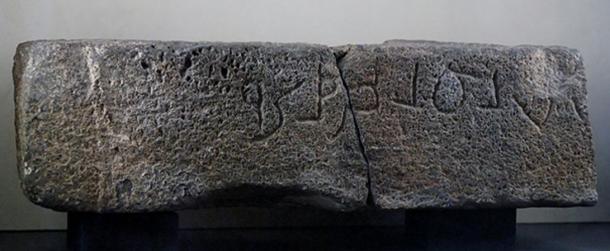 Example of Nabatean script to the god Qasiu. Basalt, 1st century AD. Found in Sia in the Hauran, Southern Syria. ( Public Domain )
Example of Nabatean script to the god Qasiu. Basalt, 1st century AD. Found in Sia in the Hauran, Southern Syria. ( Public Domain )
The ancient text is a legacy of a once flourishing Christian community in the area also linked to the rise of an ancient Jewish kingdom that ruled over much of what is today Yemen and Saudi Arabia
Christians in the Desert
The Muslim tradition preserved in the book of Koran portrays the pre-Islamic region as chaotic and filled with unrest that Mohammed manages to unify with the help of the powerful message of Islam
However, the Islamic text makes no mention of the numerous Christian and Jewish communities across the Saudi peninsula that flourished during the days of Mohammed.
Recent studies of works by ancient Christians and Muslim records have re-shaped our image of the societies that existed in the region and shed new light on the complex history of the region before the advent of Islam. One of the important kingdoms in Arabia at the time was the Jewish kingdom of Himyar.
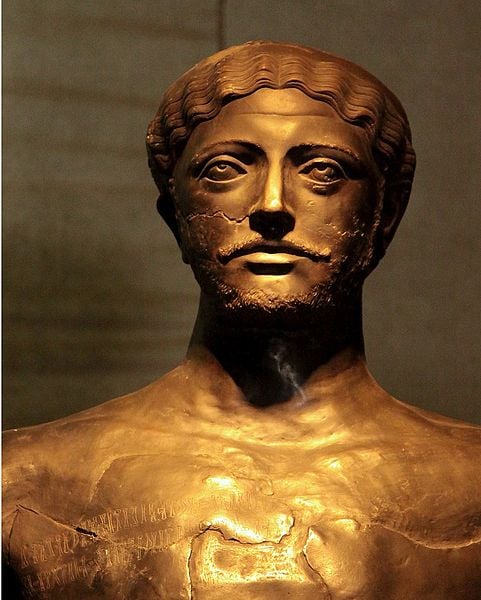 A bronze statue of Dhamar Ali Yahbur II, a Himyarite King who probably reigned in late 3rd or early 4th century AD. Displayed in Sana'a National Museum. ( CC BY 2.0 )
A bronze statue of Dhamar Ali Yahbur II, a Himyarite King who probably reigned in late 3rd or early 4th century AD. Displayed in Sana'a National Museum. ( CC BY 2.0 )
The kingdom was founded in the 2nd century AD, and around 380 AD the elites of the kingdom of Himyar converted to some form of Judaism. By the 4th century,
Himyar had become an important player in the struggle for regional power. The Kingdom of Himyar’s headquarters was situated in what is today Yemen, from where its expansionist rulers led a series of campaigns conquering into its neighboring states, including the legendary biblical kingdom of Sheba.
Royal inscriptions found in the Saudi capital of Riyadhand and Bir Hima, north of Yemen, attest how the Himyarite kingdom during the 5th century expanded its influence into central Arabia, the Persian Gulf area, and into the region of Mecca and Medina, known as Hijaz.
 Pre-Islamic rock art of Arabia at Bir Hima, carved into the eastern foothills of the Asir Mountains of Saudi Arabia. ( CC BY 2.0 )
Pre-Islamic rock art of Arabia at Bir Hima, carved into the eastern foothills of the Asir Mountains of Saudi Arabia. ( CC BY 2.0 )
According to ancient Christian sources, the Christians of the nearby city of Najran suffered a wave of persecution by the Himyarites in 470. The name of Thawban son of Malik appears on eight inscriptions, along with the names of other Christians. The French experts believe these inscriptions are a form of commemoration of Thawban and his fellow Christians that were martyred as they refused to convert to Judaism.
The researchers believe that the Christians choice of the early Arabic script to memorialize their comrades was an act of resistance that stood in sharp contrast to the inscriptions left by Himyarite rulers in their native Sabaean. To adopt a new writing system was a way of manifesting a separation from Himyar, and at the same time, a means to approach the rest of the Arabs to unify against their common enemy.
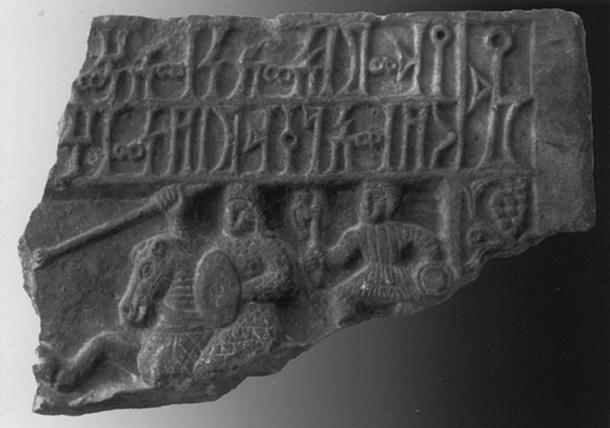 A portion of a war scene from the Himyarite era. ( CC BY SA 3.0 )
A portion of a war scene from the Himyarite era. ( CC BY SA 3.0 )
The growing resistance and outside pressure eventually brought down Himyar. In the years around 500, it fell to Christian invaders from the Ethiopian kingdom of Aksum. For the next century, Himyar was a Christian kingdom that continued to exert control over Arabia. During the latter half of the 6th century, one of its rulers, Abraha, marched through Bir Hima, conquering, Yathrib, the desert oasis that 70 years later would become known as Medina – The City of the Prophet.
The Battle of Kings Mountain: American DNA and Why the Revolution Matters Today
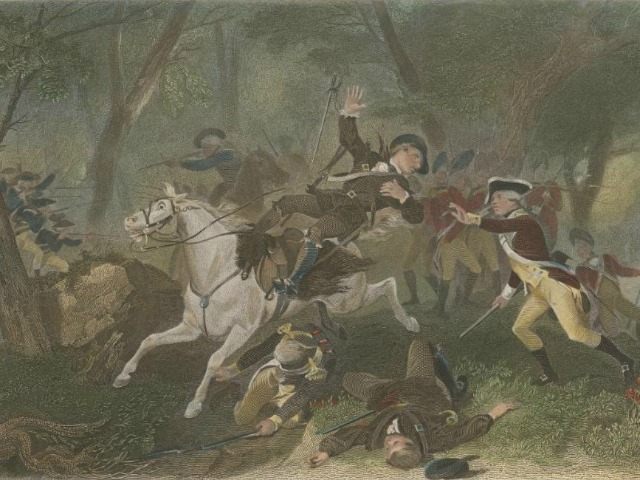
During these turbulent times, Americans are hurting, confused, and angry. Many are asking how we got here and are questioning the wisdom of established organizations. They are looking back to understand how the United States came to be and who we are as Americans.
Americans have a unique DNA, formed in the crucible of eight difficult years of revolution, and even an underreported civil war—it is the reason why the War of Independence and the greatest generation of Americans who forged this nation are so relevant today. One of the inflection points initiating a chain of events that changed the course of the Revolution was the decisive victory at Kings Mountain. On a lonely mountain in South Carolina, Americans took matters into their own hands.
Washington’s Immortals, a new bestselling book published this month, spans eight years of war. This unique book is the first Band of Brothers treatment of the American Revolution, capturing the most important elements of the Battle of Kings Mountain and nearly every other major battle of the Revolution.
Throughout most of 1780, the Revolution endured some of its darkest days. The war stalemated in the North, and the British turned their sights to the South. In May, a British army led by Henry Clinton and Charles, Earl Cornwallis, conquered Charleston and captured nearly 6,000 American soldiers – the largest haul of American prisoners of the war. The Crown was on a roll; in August, they destroyed “The Grand” Army led by General Horatio “Granny” Gates at the Battle of Camden. After the debacle, France considered pulling the plug on funding and troops earmarked for America. Russia and Austria even flirted with the idea of acting as peace mediators to find a “political solution” to the Revolution.
Divided along religious, nationality, and regional lines, South Carolina was embroiled in bitter violence: hangings and burnings between Patriot Americans and Loyalists were commonplace and part of a civil war that roiled many states. The string of stunning British victories had a galvanizing effect on Americans loyal to the Crown; Tory militia led by Scottish born Lt. Colonel Patrick Ferguson coalesced around Cornwallis’s army, who, occupying South Carolina, planned an invasion of North Carolina.
Ferguson, an inventor of a breach loading rifle and a crack shot who once had Washington in the sights of his rifle, mobilized the Tory population. The firebrand British officer planned to snuff out opposition to the Crown with brute force and boldly proclaimed: “If they do not desist from their opposition to the British arms, we would march over the mountains, hang their leaders and lay their country waste with fire and sword.” He followed up his proclamation with a stern warning to Tories and Patriots alike, “Gentlemen, unless you wish to be eat up by the inundation of the barbarians…if you wish to be pissed upon by a set of mongrels, and let your women turn their backs upon you, and look out for real men to protect them.”
Ferguson’s words thoroughly pissed off a rugged group of Americans known as the Overmountain Men. These pioneering, independent Americans had defied the king and settled beyond the Royal Proclamation Line of 1763, which established everything west of the Appalachian Mountains as Indian territory. Considered illegal squatters, they inhabited what is today the extreme northeast corner of Tennessee, where Tennessee, North Carolina, and Virginia meet.
True pioneers, hardened by years of living on the frontier, the Overmountain Men fought constantly for their survival against both the elements and the Indians. That hard living had shaped the men’s bodies, “they were the most powerful-looking men, [I] ever beheld; not overburdened with fat, but tall, raw-boned, and sinewy with long matted hair—such men as a body were never before seen in the Carolinas.” As one backwoodsman later described, “We were all for liberty…we were formidable… Our equals were scarce, and our superiors hard to find.” Washington formed an army from these men and many others, from all walks of life and class throughout the thirteen states; many had their own concepts of liberty, each contributing to unique America DNA.
The Overmountain Men rejected the established order of the Crown and were not having Ferguson or his Loyalists. The Scot’s foolhardy boast mobilized their ranks to take care of business and crush Ferguson, who was moving north to screen Cornwallis’s army that was marching north to invade North Carolina, attempting to vanquish any opposing Patriot forces along the way. On the first week of October 1780, Ferguson and a band of Loyalists fatefully bivouacked on Kings Mountain near South Carolina’s border with North Carolina, near the small town of Blacksburg.
Through intelligence gleaned from the locals, the Overmountain Men quickly discovered Ferguson’s whereabouts and surrounded Kings Mountain. Militiaman James Collins, only a teenager at the time whose family had suffered at the hands of Loyalists, recalled the moments leading up to the battle, “The sky was overcast with clouds, and at times a light mist was falling; our provisions were scanty and hungry men were like to be fractious; each one felt his situation; the last stake was up and the severity of the game must be played; everything was at stake—life, liberty, property, and even the fate of wife, children, and friends seemed to depend on the issue: death or victory was the only way to escape suffering.”
Collins and his fellow Americans received their orders before charging the mountain: “Fresh prime your guns, and every man go into battle firmly resolving to fight till he dies.” About 900 Overmountain Men assaulted Kings Mountain, where about 1,125 of Ferguson’s Loyalists encamped. Weaving between boulders and rocks, Collins and the Patriots charged the Loyalist position. Twice, Ferguson and his men repelled the Overmountain Men’s assault, but the Loyalists’ musket volleys, due to their elevated position, often went over the heads of Collins and his fellow Patriots. One Patriot soldier recalled, “The fight seemed to become more furious. Their leader Ferguson came into full view, within rifle shot, as if to encourage his men.” Collins and the men charged for a third time. The Loyalists’ ranks began to melt away. Sensing victory, the officers roared, “Hurrah, my brave fellows! Advance!”
Ferguson, on horseback, attempted to rally the Loyalists, waving his gleaming sword as he rode from one end of the line to the other, but despite his efforts, white flags of surrender began to appear. Ferguson’s two beautiful mistresses, known as Virginia Sal and Virginia Paul, were on the mountain. Many Overmountain Men refused to accept their surrender, recalling earlier British atrocities. The rout continued as the Overmountian Men pelted Ferguson with scores of rounds, his body riddled with musket balls as he fell. Nearby, Virginia Sal was struck in the head with a musket ball; Virginia Paul escaped death. Nearly 700 Loyalists surrendered; scores fell in the battle. The Patriots hastily buried the dead under leaves, old logs, and rocks. It did not keep the wild boars at bay, “The hogs in the neighborhood gathered into the place to devour the flesh of men.”
The victory of the Overmountain Men served as a turning point in the South. British General Henry Clinton summed up the battle: “[Kings Mountain] unhappily proved the first link in the chain of evils that followed each other in regular succession until they at last ended in the total loss of America.” Despite the victory, Washington’s Immortal, Brigadier General Mordecai Gist, seems to issue an ominous warning about America’s internal politics that threatened the Revolution and morphing into what America fought against: “…if we neglect to support it [United States] with Dignity or to aim at national Glory, if we cease to sacrifice private Interests to public Good, the Blessing will corrupt at our touch and like an affectionate love, worn out by Injuries, grow into a hated Monster.”
The Secret Racist History of the Democratic Party
By Kimberly Bloom Jackson
Have you heard of Josiah Walls or Hiram Rhodes Revels? How about Joseph Hayne Rainey? If not, you’re not alone. I taught history and I never knew half of our nation’s past until I began to re-educate myself by learning from original source materials, rather than modern textbooks written by progressive Democrats with an agenda.
Interestingly, Democrats have long ago erased these historic figures from our textbooks, only to offer deceitful propaganda and economic enticements in an effort to convince people, especially black Americans, that it’s the Democrats rather than Republicans who are the true saviors of civil liberties. Luckily, we can still venture back into America’s real historical record to find that facts are stubborn things. Let’s take a closer look.
An 1872 print by Currier and Ives depicts the first seven black Americans elected to the U.S. Congress during the Reconstruction period of 1865 to 1877-- and they’re all Republican!
From left to right:

Sen. Hiram Rhodes Revels, R-MS (1822-1901): Already an ordained minister, Revels served as an army chaplain and was responsible for recruiting three additional regiments during the Civil War. He was also elected to the Mississippi Senate in 1869 and the U.S. Senate in 1870, making him America’s first black senator.
Rep. Benjamin Turner, R-AL (1825-1894): Within just five years, Turner went from slave to wealthy businessman. He also became a delegate to the Alabama Republican State Convention of 1867 and a member of the Selma City Council in 1868. In 1871, Turner was even elected to the U.S. Congress.
Rep. Robert DeLarge, R-SC (1842-1874): Although born a slave, DeLarge chaired the Republican Platform Committee in 1867 and served as delegate at the Constitutional Convention of 1868. From 1868 to 1870, he was also elected to the State House of Representatives and later Congress, serving from 1871 to 1873.
Rep. Josiah Walls, R-FL (1842-1905): Walls was a slave who was forced to fight for the Confederate Army until he was captured by Union troops. He promptly enlisted with the Union and eventually became an officer. In 1870, he was elected to the U.S. Senate. Unfortunately, harassing Democrats questioned his qualifications until he was officially expelled. Although he was re-elected after the first legal challenge, Democrats took control of Florida and Walls was prohibited from returning altogether.
Rep. Jefferson Long, R-GA (1836-1901): Long was also born into slavery, and he too became a successful business man. However, when Democrats boycotted his business he suffered substantial financial loses. But that didn’t stop Long, who in 1871 became the first black representative to deliver a congressional speech in the U.S. House.
Rep. Joseph Hayne Rainey, R-SC (1832-1887): Although born a slave, Rainey became the first black Speaker of the U.S. House for a brief period in 1870. In fact, he served in Congress longer than any other black America at that time.
Rep. Robert Brown Elliot, R-SC (1842-1884): Elliot helped to organize the Republican Party throughout rural South Carolina. He was elected to the U.S. House of Representatives in 1870 and reelected in 1872. In 1874, he was elected to the State House of Representatives and eventually served as Speaker of the House in the State Legislature.
Clearly, the latter half of the 19th Century, and for much of the early half of the 20th Century, it was the Republican Party that was the party of choice for blacks. How can this be? Because the Republican Party was formed in the late 1850s as an oppositional force to the pro-slavery Democratic Party. Republicans wanted to return to the principles that were originally established in the republic’s founding documents and in doing so became the first party to openly advocated strong civil rights legislation. Voters took notice and in 1860 Abraham Lincoln was elected President along with a Republican Congress. This infuriated the southern Democrats, who soon afterwards left Congress and took their states with them to form what officially became known as The Slaveholding Confederate States of America.
Meanwhile, Republicans pushed full steam ahead. Take, for example, the Thirteenth Amendment to the Constitution that officially abolished slavery in 1864. Of the 118 Republicans in Congress (House and Senate) at the time, all 118 voted in favor of the legislation, while only 19 of 82 Democrats voted likewise. Then there’s the Fourteenth and Fifteenth Amendments guaranteeing rights of citizenship and voting to black males. Not a single Democrat voted in favor of either the Fourteenth (House and Senate) or Fifteenth (House and Senate) Amendments.
In spite of this, in almost every Southern state, the Republican Party was actually formed by blacks, not whites. Case in point is Houston, Texas, where 150 blacks and 20 whites created the Republican Party of Texas. But perhaps most telling of all with respect to the Republican Party’s achievements is that black men were continuously elected to public office. For example, 42 blacks were elected to the Texas legislature, 112 in Mississippi, 190 in South Carolina, 95 representatives and 32 senators in Louisiana, and many more elected in other states -- all Republican. Democrats didn’t elect their first black American to the U.S. House until 1935!
Political Gangs With Pointy Hoods
By the mid-1860s, the Republican Party’s alliance with blacks had caused a noticeable strain on the Democrats’ struggle for electoral significance in the post-Civil War era. This prompted the Democratic Party in 1866 to develop a new pseudo-secret political action group whose sole purpose was to help gain control of the electorate. The new group was known simply by their initials, KKK (Ku Klux Klan).
This political relationship was nationally solidified shortly thereafter during the 1868 Democratic National Convention when former Civil War General Nathan Bedford Forrest was honored as the KKK’s first Grand Wizard. But don’t bother checking the Democratic National Committee’s website for proof. For many years, even up through the 2012 Presidential Election, the DNC had omitted all related history from 1848 to 1900 from their timeline -- half a century worth! Now, for the 2016 election cycle, they’ve scratched even more history. Apparently, they believe it’s easier to just lie and claim to have fought for civil rights for over 200 hundred years, while seeing fit to list only a select few distorted events as exemplary, beginning as late as the 1920s. Incredibly, the DNC conveniently jumps past more than 100 years of American history!
Nevertheless, this sordid history is still well documented. There’s even a thirteen-volume set of Congressional investigations dating from 1872 detailing the Klan’s connection to the Democratic Party. The official documents, titled Report of the Joint Select Committee to Inquire Into the Condition of Affairs in the Late Insurrectionary States, irrefutably proves the KKK’s prominent role in the Democratic Party.
One of the most vivid examples of collusion between the KKK and Democratic Party was when Democrat Senator Wade Hampton ran for the governorship of South Carolina in 1876. The Klan put into action a battle plan to help Democrats win, stating: “Every Democrat must feel honor bound to control the vote of at least one Negro by intimidation…. Democrats must go in as large numbers…and well-armed.” An issue of Harper’s Weekly that same year illustrated this mindset with a depiction of two white Democrats standing next to a black man while pointing a gun at him. At the bottom of the depiction is a caption that reads: “Of Course He Wants To Vote The Democratic Ticket!”

This is reminiscent of the 2008 Presidential election when members of the New Black Panther Party hung out at a Philadelphia precinct wielding big batons.

The Klan’s primary mission was to intimidate Republicans -- black and white. In South Carolina, for example, the Klan even passed out “push cards” -- a hit list of 63 (50 blacks and 13 whites) “Radicals” of the legislature pictured on one side and their names listed on the other. Democrats called Republicans radicals not just because they were a powerful political force, but because they allowed blacks to participate in the political process. Apparently, this was all too much for Democrats to bear.
By 1875, Republicans, both black and white, had worked together to pass over two dozen civil rights bills. Unfortunately, their momentum came to a screeching halt in 1876 when the Democratic Party took control of Congress. Hell bent on preventing blacks from voting, Southern Democrats devised nearly a dozen shady schemes, like requiring literacy tests, misleading election procedures, redrawing election lines, changing polling locations, creating white-only primaries, and even rewriting state constitutions. Talk about disenfranchising black voters!
There were also lynchings, but not what you might think. According to the University of Missouri-Kansas City School of Law, between 1882 and 1964 an estimated 3,446 blacks and 1,279 whites were lynched at the hands of the Klan.
Today, the Democratic Party no longer needs the help of political gangs wearing pointy hoods to do their dirty work. Instead, they do it themselves. You may recall the case of black Tea Party activist Kenneth Gladney, who was brutally beaten by two SEIU members during a 2009 health care town hall meeting. In February 2011, a union thug with Communications Workers of America was caught on tape physically assaulting a young female FreedomWorks activist in Washington, DC. Then in 2012, Michigan Education Association President Steve Cook jumped on the protest bandwagon against the state’s new right-to-work legislation stating, “Whoever votes for this is not going to have any peace for the next two years.” An even worse threat was issued on the floor of the Michigan House of Representatives the next day by Democratic Representative Douglas Geiss who charged, “There will be blood!”
As we forge ahead into this critical 2016 election season, let us not forget the real history of America when blacks and whites, primarily Republicans, worked side by side defending the rights and dignity of all Americans. It’s a history that has been kept out of the history books--a history that today’s Democrats routinely lie about while promptly pointing their finger at Republicans, calling white Republicans racists and black Republicans Uncle Toms. This is because Democrats have a secret past that must be protected and an agenda that must be fulfilled. If history is any indication of what the future might hold, brace yourself. There will be some in the Democratic Party who will be prepared to do whatever it takes to silence any opposition.

WWII Stories– August 9th, 2003, they laid the remains of Glenn Rojohn to rest in the Peace Lutheran Cemetery in the little town of Greenock, Pa., just southeast of Pittsburgh. He was 81, and had been in the air conditioning and plumbing business in nearby McKeesport. If you had seen him on the street he would probably have looked to you like so many other graying, bespectacled old World War II veterans whose names appear so often now on obituary pages.
But like so many of them, though he seldom talked about it, he could have told you one hell of a story. He won the Air Medal, the Distinguished Flying Cross and the Purple Heart all in one fell swoop in the skies over Germany on December 31, 1944.
Fell swoop indeed.
Capt. Glenn Rojohn, of the 8th Air Force’s 100th Bomb Group was flying his B-17G Flying Fortress bomber on a raid over Hamburg. His formation had braved heavy flak to drop their bombs, then turned 180 degrees to head out over the North Sea.
They had finally turned northwest, headed back to England, when they were jumped by German fighters at 22,000 feet. The Messerschmitt Me-109s pressed their attack so closely that Capt. Rojohn could see the faces of the German pilots.
He and other pilots fought to remain in formation so they could use each other’s guns to defend the group. Rojohn saw a B-17 ahead of him burst into flames and slide sickeningly toward the earth. He gunned his ship forward to fill in the gap.
He felt a huge impact. The big bomber shuddered, felt suddenly very heavy and began losing altitude. Rojohn grasped almost immediately that he had collided with another plane. A B-17 below him, piloted by Lt. William G. McNab, had slammed the top of its fuselage into the bottom of Rojohn’s. The top turret gun of McNab’s plane was now locked in the belly of Rojohn’s plane and the ball turret in the belly of Rojohn’s had smashed through the top of McNab’s. The two bombers were almost perfectly aligned — the tail of the lower plane was slightly to the left of Rojohn’s tailpiece. They were stuck together, as a crewman later recalled, “like mating dragon flies.”
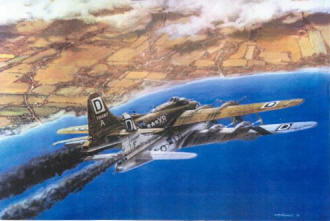
Three of the engines on the bottom plane were still running, as were all four of Rojohn’s. The fourth engine on the lower bomber was on fire and the flames were spreading to the rest of the aircraft. The two were losing altitude quickly. Rojohn tried several times to gun his engines and break free of the other plane. The two were inextricably locked together. Fearing a fire, Rojohn cut his engines and rang the bailout bell. For his crew to have any chance of parachuting, he had to keep the plane under control somehow.
The ball turret, hanging below the belly of the B-17, was considered by many to be a death trap — the worst station on the bomber. In this case, both ball turrets figured in a swift and terrible drama of life and death. Staff Sgt. Edward L. Woodall, Jr., in the ball turret of the lower bomber had felt the impact of the collision above him and saw shards of metal drop past him. Worse, he realized both electrical and hydraulic power was gone.
Remembering escape drills, he grabbed the handcrank, released the clutch and cranked the turret and its guns until they were straight down, then turned and climbed out the back of the turret up into the fuselage.
Once inside the plane’s belly Woodall saw a chilling sight, the ball turret of the other bomber protruding through the top of the fuselage. In that turret, hopelessly trapped, was Staff Sgt. Joseph Russo. Several crewmembers of Rojohn’s plane tried frantically to crank Russo’s turret around so he could escape, but, jammed into the fuselage of the lower plane, it would not budge. Perhaps unaware that his voice was going out over the intercom of his plane, Sgt. Russo began reciting his Hail Marys.
Up in the cockpit, Capt. Rojohn and his co-pilot 2nd Lt. William G. Leek, Jr., had propped their feet against the instrument panel so they could pull back on their controls with all their strength, trying to prevent their plane from going into a spinning dive that would prevent the crew from jumping out.
Capt. Rojohn motion left and the two managed to wheel the huge, collision-born hybrid of a plane back toward the German coast. Leek felt like he was intruding on Sgt. Russo as his prayers crackled over the radio, so he pulled off his flying helmet with its earphones.
Rojohn, immediately grasping that crew could not exit from the bottom of his plane, ordered his top turret gunner and his radio operator, Tech Sgts. Orville Elkin and Edward G. Neuhaus to make their way to the back of the fuselage and out the waist door on the left behind the wing.
Then he got his navigator, 2nd Lt. Robert Washington, and his bombardier, Sgt. James Shirley to follow them. As Rojohn and Leek somehow held the plane steady, these four men, as well as waist gunner, Sgt. Roy Little, and tail gunner, Staff Sgt. Francis Chase, were able to bail out.
Now the plane locked below them was aflame. Fire poured over Rojohn’s left wing. He could feel the heat from the plane below and hear the sound of .50 machinegun ammunition “cooking off” in the flames.
Capt. Rojohn ordered Lieut. Leek to bail out. Leek knew that without him helping keep the controls back, the plane would drop in a flaming spiral and the centrifugal force would prevent Rojohn from bailing. He refused the order.
Meanwhile, German soldiers and civilians on the ground that afternoon looked up in wonder. Some of them thought they were seeing a new Allied secret weapon — a strange eight-engined double bomber. But anti-aircraft gunners on the North Sea coastal island of Wangerooge had seen the collision. A German battery captain wrote in his logbook at 12:47 p.m.:
“Two fortresses collided in a formation in the NE. The planes flew hooked together and flew 20 miles south. The two planes were unable to fight anymore. The crash could be awaited so I stopped the firing at these two planes.”
Suspended in his parachute in the cold December sky, Bob Washington watched with deadly fascination as the mated bombers, trailing black smoke, fell to earth about three miles away, their downward trip ending in an ugly boiling blossom of fire.
In the cockpit Rojohn and Leek held grimly to the controls trying to ride a falling rock. Leek tersely recalled, “The ground came up faster and faster. Praying was allowed. We gave it one last effort and slammed into the ground.”
The McNab plane on the bottom exploded, vaulting the other B-17 upward and forward. It slammed back to the ground, sliding along until its left wing slammed through a wooden building and the smoldering mess of came to a stop.
Rojohn and Leek were still seated in their cockpit. The nose of the plane was relatively intact, but everything from the B-17 massive wings back was destroyed. They looked at each other incredulously. Neither was badly injured.
Movies have nothing on reality. Still perhaps in shock, Leek crawled out through a huge hole behind the cockpit, felt for the familiar pack in his uniform pocket pulled out a cigarette. He placed it in his mouth and was about to light it. Then he noticed a young German soldier pointing a rifle at him. The soldier looked scared and annoyed.
He grabbed the cigarette out of Leak’s mouth and pointed down to the gasoline pouring out over the wing from a ruptured fuel tank.
Two of the six men who parachuted from Rojohn’s plane did not survive the jump. But the other four and, amazingly, four men from the other bomber, including ball turret gunner Woodall, survived. All were taken prisoner. Several of them were interrogated at length by the Germans until they were satisfied that what had crashed was not a new American secret weapon.
Rojohn, typically, didn’t talk much about his Distinguished Flying Cross. Of Leek, he said, ‘in all fairness to my co-pilot, he’s the reason I’m alive today.”
Like so many veterans, Rojohn got unsentimentally back to life after the war, marrying and raising a son and daughter. For many years, though, he tried to link back up with Leek, going through government records to try to track him down. It took him 40 years, but in 1986, he found the number of Leeks’ mother, in Washington State.
Yes, her son Bill was visiting from California. Would Rojohn like to speak with him? Some things are better left unsaid. One can imagine that first conversation between the two men who had shared that wild ride in the cockpit of a B-17.
A year later, the two were re-united at a reunion of the 100th Bomb Group in Long Beach, Calif. Bill Leek died the following year.
Glenn Rojohn was the last survivor of the remarkable piggyback flight. He was like thousands upon thousands of men, soda jerks and lumberjacks, teachers and dentists, students and lawyers and service station attendants and store clerks and farm boys who in the prime of their lives went to war.
He died last Saturday after a long siege of sickness. But he apparently faced that final battle with the same grim aplomb he displayed that remarkable day over Germany so long ago. Let us be thankful for such men.

Mix of Wild, Domestic Animals Contributed to Ötzi the Iceman’s Wardrobe

Ötzi the Iceman, the famed and well-preserved mummy found in a glacier in the Italian Alps in 1991, has provided a wealth of information about the lives of ancient Europeans over the last 25 years.
Since the discovery of the 5,300-year-old remains, scientists have revealed clues into Ötzi’s ancestry, diet, tools, lifestyle and health. Now researchers in Italy have learned even more by identifying the various species of animals Ötzi wore as clothing.
The mummified remains were found with a full wardrobe – including a hide coat, skin leggings, fur hat and shoes. But as the researchers of the new study explained, there were some challenges in identifying the species of animals used to craft the pieces. The leather from the outfit could have been scraped and exposed to intense heat to craft the clothing. The materials could have also been contaminated when handled by researchers after the initial discovery, and the freeze-drying method used to help preserve the find may have caused further damage to the genetic material, according to the study.
But by using next-generation sequencing techniques, the research team was able to enhance certain target strands of DNA to identify the animal species associated with nine samples of leather and fur from the various pieces of clothing.
The majority of the samples were made from domestic species. Analysis showed that Ötzi’s leather loincloth and hide coat were stitched from sheepskin, which had already been identified in previous studies. But the new analysis revealed that the sheep species is more closely related to modern domestic European sheep than their wild cousins.
It also showed that the coat was crafted from both sheep and goat, and at least four individual animals were used.
His leggings were also from goat leather, not wolf, fox or dog as previously believed. Furthermore, cattle hide was used to fashion Ötzi’s shoes, which were stuffed with hay for added warmth.
Intriguing to the researchers, the hat and quiver found with Ötzi were produced from wild species – brown bear and roe deer, respectively.
“These results suggest that Copper Age populations made considered choices of clothing material from both the wild and domestic populations available to them,” wrote the researchers. “Moreover, these results show the potential for the recovery of complete mitochondrial genomes from degraded prehistoric artifacts.”
The evidence of wild animals suggests that Ötzi had access and the capability to trap and hunt game, or possibly traded to acquire the materials.
The study was published today in Scientific Reports.

?Why you still know the name of a 19th century weapon.

By Matthew Moss
In April 1861, Richard Jordan Gatling watched hundreds of Union soldiers march through Indianapolis, ready to ride the rails to the front. In the opposite direction came a never-ending stream of badly wounded men, to say nothing of those who lost their lives. Gatling set about inventing a 'labor-saving device for warfare' that he hoped would minimize the number of men needed to fight a war, and thus minimize the number of men exposed to its horrors.
Working throughout the summer of 1861, Gatling developed the invention that would carry his name though history: the Gatling gun. The Gatling is the most famous of late 19th century's manual machine guns. In an age of slow-loading rifles, the Gatling offered unprecedented firepower. Even today, a century and a half after its design, the gun retains its iconic status. So why does the world still know the name of gun that's been obsolete for a hundred years?

Richard Gatling's patent for 'Improvement in Battery Guns' US Patent Office
Gatling would refine the basic design of his gun over its 40-year lifespan, but the basic operation remained the same. The Gatling featured four to ten barrels arrayed around a central axis and a top-loading magazine which loaded each barrel in turn before the continuing turn of the gun's crank fired the weapon. Each barrel fired with one turn of the crank, and the weapon's rate of fire was limited only by the speed at which the gunner could crank it. Early models fired up to 200 rounds per minute; later ones could get up to 700 to 1,000 rounds in 60 seconds.
Yet this fast-firing weapon got off to a slow start. Gatling earned his first patent in November 1862, for the "Improvement in revolving battery-guns," his idea for reducing the number of men needed to fight the American Civil War. In hindsight, we know how flawed this logic proved to be, as the Gatling gun and later machine guns caused untold death and destruction. At the time, Gatling had a difficult path even getting his weapon into the war. While the new weapon was promising the US army's reluctance to embrace the machine gun meant Gatling was ignored, at least at first.
It wasn't until summer 1863 that the Washington Navy Yard testing the Gatling gun, with an evaluating officer reporting: "The mechanical construction is very simple, the workmanship is well executed, and we are of the opinion that it is not liable to get out of working order." Despite this glowing report, the U.S. Navy declined to adopt the gun and it would wait another three years before the military took it seriously. A few Army officers bought Gatling guns themselves, but the invention would see little action in the war that inspired its creation.

A battery of 1-inch Gatling guns in Dakota Territory, c.1877. U.S. Army
The U.S. Army made its first order for 50 1-inch and 50 .50-caliber Gatling guns in 1866, right after war's end, and Gatling approached Colt to manufacture them. Following tests at Fort Monroe, the U.S. Army used the Gatling extensively throughout the 1870s during its campaigns against Native American tribes in the West. Custer's 7th Cavalry left their two Gatling guns behind when they embarked on the ill-fated 1876 summer expedition of the Great Sioux War. Custer believed they'd slow his advance, but without them, he and his men were famously overwhelmed and massacred.
Foreign interest charged up. In Europe, Russia became the first country to buy Gatling guns directly from Colt while the British W.G. Armstrong & Co. became one of the first European manufacturers to purchase a license to build and sell the new weapons
The first British use of the Gatling gun came in 1879 during the Zulu War. At the Battle of Gingindlovu, two guns broke up a Zulu attack with long bursts of suppressive fire that forced the Zulus to take cover. At the Battle of Ulundi the guns were used to great effect, despite several jams. The British commander, Lord Chelmsford, later wrote that the Gatlings: "proved a very valuable addition… machine guns are, I consider, most valuable weapons… where the odds against us must necessarily be great."
Indeed, this statement typified the use of the Gatling during the late 19th century: The guns, with their incredible volume of firepower for the time, acted as force multipliers in engagements where the enemy were far more numerous. The Gatling would go with British units to Afghanistan, Egypt, and the Sudan in the late 1800s, remaining in service until the Maxim gun came around.
The British were not the only European nation to embrace the Gatling gun, Imperial Russia made large orders, and the Tsar used his Gatling guns against the Ottoman Empire during the Russo-Turkish War 1877-8 and again in 1905 during the Russo-Japanese War. Gatling guns went to South America during the War of the Pacific, with Peru deploying them first in 1879. By 1880, nations and individuals around the world had bought Dr. Gatling's guns.
The Gatling gun of the late 1870s was greatly improved from the early models, of tremendous rates of fire they were lighter, more reliable and extremely well made. The improved Gatling gun's finest hour came during the Spanish-American War. During the Battle of San Juan Hill, Lieutenant John Parker's Gatling Gun detachment laid down suppressive fire on Spanish positions by firing over 18,000 rounds during the American attack, preventing the Spanish from firing down on the U.S. forces. The detachment turned back the Spanish counter-attacks, too, by decimating an attacking battalion of Spanish regulars. This success helped to prove to the U.S. Army that machine guns could be used offensively as well as defensively, with President Theodore Roosevelt himself praising Parker's "invaluable work on the field of battle, as much in attack as in defense."
But the end would come soon.

Officers of the US Marine Corps pose with two Gatling Guns, c.1896 USMC Historical
Despite American forces using the weapon into the 1890s, the Gatling gun fast became obsolete. The culprit in its quick death was Hiram Maxim's new automatic machine gun, introduced in 1886. The weapon would come to define early 20th century warfare. Maxim's gun was recoil-operated, using the recoil energy created when the weapon was fired to cycle the action. Feeding from a cloth belt, the Maxim could fire up to 600 round per minute.
Gatling tried several times to revive his design after he saw market share slipping away. In 1893 he patented a Gatling powered by an electric motor. In 1895, he tried to create a truly automatic gas-operated Gatling gun. These designs proved to be too complex or cumbersome, losing the simple practicality that made the original Gatling so good. In 1911, the U.S. Army declared all its remaining Gatling guns obsolete and began a process of rearming with automatic machine guns.
Gatling himself never confined his life's work to firearms design. The inventor patented a successful seed planter and wheat drill in 1855. He later patented designs for flushing toilets, a device to control wagon reins, and a steam plough. He died in February 1903 at the age of 84.
More than a hundred years later, the Gatling gun is one of a rare few weapons that are iconic and instantly recognisable. The Gatling owes a lot of its fame to its unique operation and appearance, one cemented in the public imagination first through Buffalo Bill's Wild West Shows and later through comics, pulp fiction, and countless films. Today Gatling's design lives on in the form of electrically powered M134 Minigun and fearsome auto-cannons like the GAU-8 used in the USAF's A-10. Even in the 21st century, the Gatling gun is no mere museum piece.
What Ötzi the Iceman's Voice Sounded Like
Ötzi the Iceman, the world’s favorite prehistoric mummy, has been subjected to every scientific test imaginable, since his remains were discovered poking out of a glacier high in the Italian Alps in 1991. Now, a team of Italian researchers has reconstructed Ötzi’s vocal cords and used it to reproduce what his voice may have sounded like.
The team announced the project back in February and used a series of CT scans to map the structure of the vocal cords and vocal tract, based on their length. Then they ran that data through mathematical models and special software to simulate how the vocal tract works. The result—presented yesterday at a conference in Italy celebrating the 25th anniversary of the discovery—is a rough digital approximation of a prehistoric voice.
So what does our man Ötzi sound like? It’s a rough, gravelly kind of male voice, reminiscent to some of a chain smoker. Given this sample of Italian vowels, he mostly sounds like he’s burping:
The Italian scientists still need to incorporate the effects of soft tissues in the mouth and throat, as well as the tension and density of the vocal cords, to get a more accurate reconstruction. “We can’t say we have reconstructed Ötzi’s original voice, because we miss some crucial information from the mummy,” team leader Rolando Fustos of the Bolzano General Hospital in Italy told Discovery News. “This is a starting point for further research.”
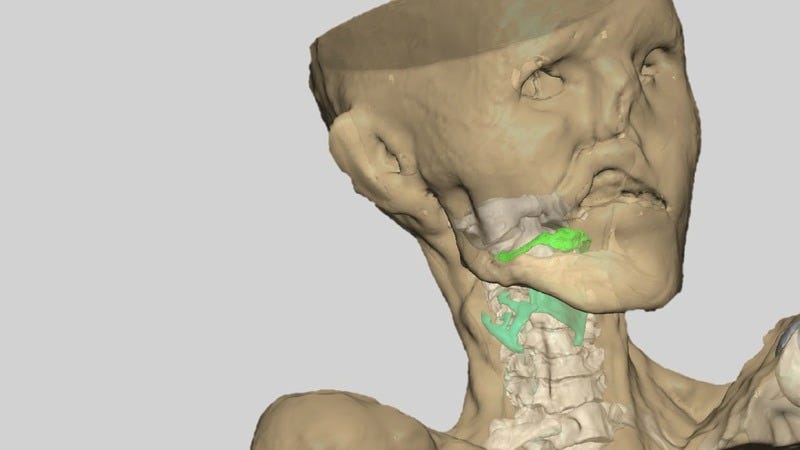

There are a couple of photos of the photographers that were taking the pictures. THEY ARE JUST AS INSANE!!!
What I love about this video is the candor. A historian actually says that it was Rockefeller that put so many people to work during the great depression. How did this scholar slip through the cracks?
Remembering Joe “Hoser” Satrapa
I was fortunate to get to watch the restoration of Shoo Shoo baby. A friend of mine was on the restoration team. What was funny when they got it completed there was no pilot at the base that knew how to fly the plane. They brought in a pilot to take her out. I wondered how the gunners didn't freeze to death in those gun turrets. They were really small inside and right out there for someone to shoot at. They also took me on an all day flight on the largest plane they had at the base in those days. It was a C5 A and we flew down over the outer banks where it all started with the Wright Brothers. I got to sit in the navigators seat and they told me not to touch any of the switches. That was where you alternated fuel tanks. I had fun and there was only the pilot, copilot and me on the flight. We ate like champs on the flight and KFC was part of it.



